Let’s start with basics: there are several INDIAS.
(Obviously, this is a ridiculously simplistic summary of a complex country like no other in complexity, i.e. the reason we love learning more about India).
Just to illustrate the concept of “several Indias” ~ there is the first world India of High Tech and Mumbai’s now global Bollywood industry; There is the India of exotic travel to the Taj Mahal, Veranasi and Rajasthan; There is the India of global yogis that bounce between Rishikesh in the North and Goa’s beaches in the Southwest; There is the india of IT outsourcing in Bangalore; There is the poor and densely populated India of Calcutta. You get the point.
Given the fact that the country, now the second most populated country in the world, with the fastest growing GNP in the world, with the largest contiguous border with China, i.e. a “natural” and historic check on an expansionist and increasingly bellicose China, there is also the geopolitically important India. Given my (Ben’s) interest in global security issues, this alone makes this India a fascinating place.
But for this trip, our third together in India, we want to get a bit more exposure to one other India. The India of TRIBAL lands. While India is a mind boggling construct of literally over one hundred languages, myriad ethnicities and religions, one might say that the search for Tribal India could take one anywhere. But in fact, the purest and clearest locus for this particular India, is the North Eastern region of India, called “the seven sisters”, for the seven states that comprise North East India.
It takes but a glance at the maps below to understand that this region is India, but… also not quite. If there is anything remotely close to homogeneity (and we are stretching the concept of homogeneous here), it is easy to understand that this part of India stands apart. In fact, for a very long time, the Central Government of India was not all that interested in spending energy and central government financing to help this region develop and homogenize with the rest of the country.
This area of India was really a sort of “wild wild West” (wild wild East) where the people were just too different, spoke different languages, were mostly Buddhist and Muslims, looked different and access to the region was (and remains) complicated by the foreboding terrain and climate. At the foot of the Himalayas, whatever good intentions at “connectivity” were invested in by successive local governments, would often be reduced to naught when the monsoon seasons swelled the mighty river system and took every man-made construction in its course.
The locals, in their myriad tribal distinctions were not particularly perturbed by this lack of love from the Central government. In fact, a brutal insurgency initiated by several of the mighty tribes, like the Naga people, was aimed at obtaining independence from India, creating Nagaland. While the Naga people where the most populous, the feeling of “difference” from the rest of India is a constant in Northeast India history.
To illustrate, when the British colonial power ruled India, it triggered an almost universal hatred for the British from “mainland India” (interestingly, still the way locals refer to the bulk of India). Our intention here is not to rehash India’s history and the emotionally strong desire to expel the then ruling British Colonialists. But, in this region, almost every conversation we had points to the good deeds of the British ~ a road system that connected far flung villages, buildings such as schools and hospitals, etc.
Because the Indian mainland rulers, (pre British), had shown very little interest in this region, as they again showed little interest since independence in 1949, until very recently, there is an appreciation around these parts for the fact that the British paid attention to their needs. Even if it was self serving and mainly motivated by the desire to establish a thriving tea industry in the state of Assam. Assam tea, arguably one of the best teas in the world, became a major contributor to the economy of the state of Assam and, through a trickle down effect, to the whole region.
The recent interest by the Central government seems to be in part as a result of the “insurgency” and calls for independence, and in part as a result of China laying claim to part of the region.
Tibet, contiguous to the State of Arunachal Pradesh, has now been wholly digested by China, sad to say. The Chinese effort at extinguishing a distinct Tibetan culture has been the primary driver in Beijing’s overtly aggressive policies to entice “Han” Chinese to move to Tibet, giving them preferential financial advantages for those eager to go “colonize” Tibet. Their logic: if they can’t defeat Tibetan’s strong sense of independence, they can drown out the purity of that culture by swarming them and making them a minority in their own land. To a large extent, they have succeeded, or are succeeding. It’s a different approach to genocide, but the intention of erasing a culture is nonetheless the same.
So what does that have to do with our trip?
Well, China now refers to Arunachal Pradesh as “South Tibet” (which is not entirely absurd given that there is a commonality of culture between the Tibetan-like communities of Arunachal Pradesh). But by calling this area “South Tibet”, by some phenomenally aggressive and disingenuous act of historical revisionism, the Chinese are laying the path for an eventual expansion to seize this region from India.
So now that China wants to digest this region, the Central government of India is rediscovering its sense of brotherhood with its long abandoned Northeast.
OK, enough history, let’s just look at the geography for a bit, so that the uniqueness of the Northeast India region becomes clear:
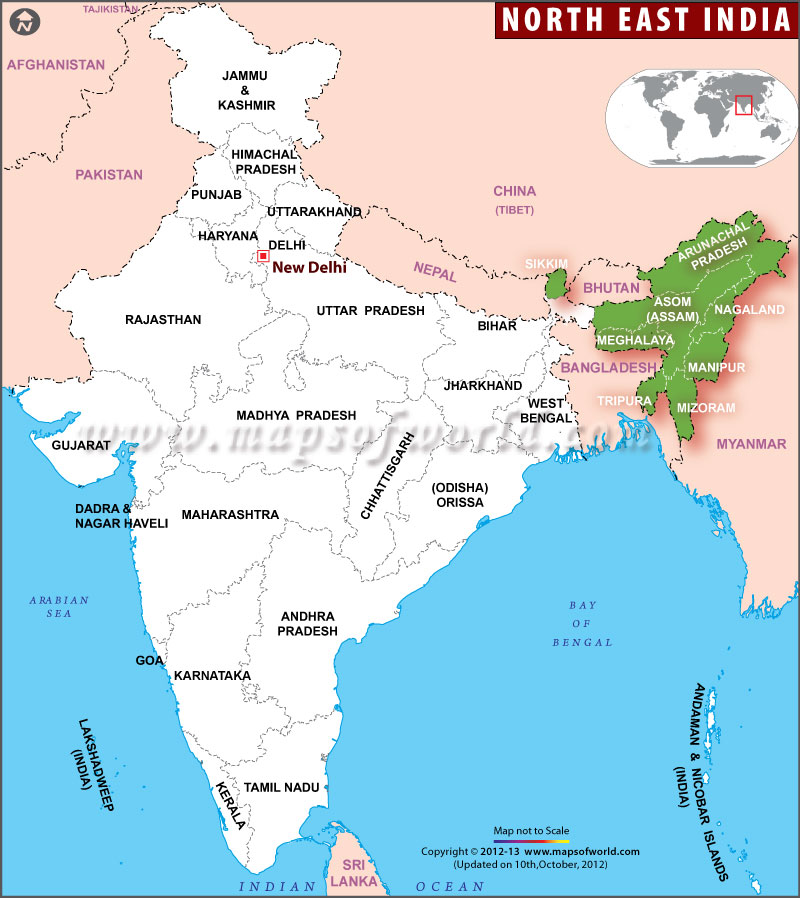
If you look at the white area, north of West Bengal and next to Bihar State, you’ll notice a TINY pin hole of an opening squeezed by Nepal to the North and Bangladesh to the South. THIS is the entrance into the Seven Sisters that comprise the Northeastern States., in green.
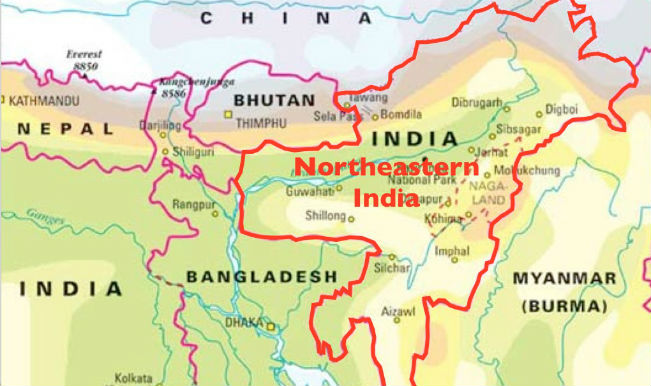
Zoom in, and you can see that this region of India is surrounded by Bangladesh to the South West, Bhutan and China to the North, Myanmar to the East.

For those obsessed with the reality of Climate Change, like ourselves, the key map is this one: the thick beautiful blue line is the mighty river system that flows through this region. It remains today a critical asset of the region, even as the rest of India is experiencing crushing change in climate that is predicted to lead to a very harsh reality about the availability of water, in the decades to come. It is not accidental that Prime Minister Modi has projected that India’s growth in the future, will come from Northeast India. Way less populated than the rest of India, under developed if compared to “mainland India”, this area still has water. But the water flow is visibly drastically reduced from what it was just one decade ago. Why? because dams have been built, both in India and China, to “steal” from this region, or reroute the fresh water to population centers.
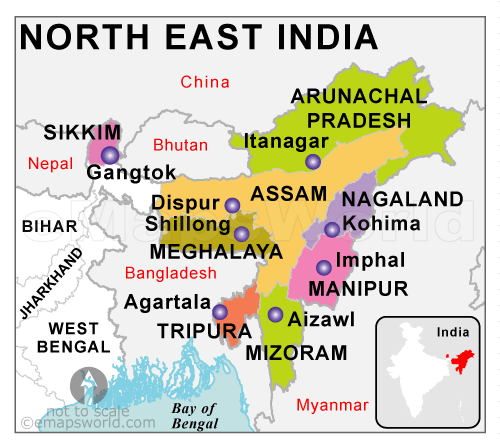
One last important piece of geography: there is a population remix going on in this area. Three regions are exporting massive amounts of hard working, unemployed farmers and tradesmen from Bihar and West Bengal in India, and from Bangladesh. These people are rumored to have a different work ethic than the tribal people, who have had different cultural priorities than the constant pressure to produce. As a result, these immigrants searching for work, are increasingly preferred to local tribal workers, and thus a cycle of impoverishing the local earnest “people of the land” has started. This is a demographic crisis in the making that will not end well.
This historical, geographic and economic “backgrounder” by Ben, we hope, provides useful context so that we can now take a walk in the streets of Assam and explore…
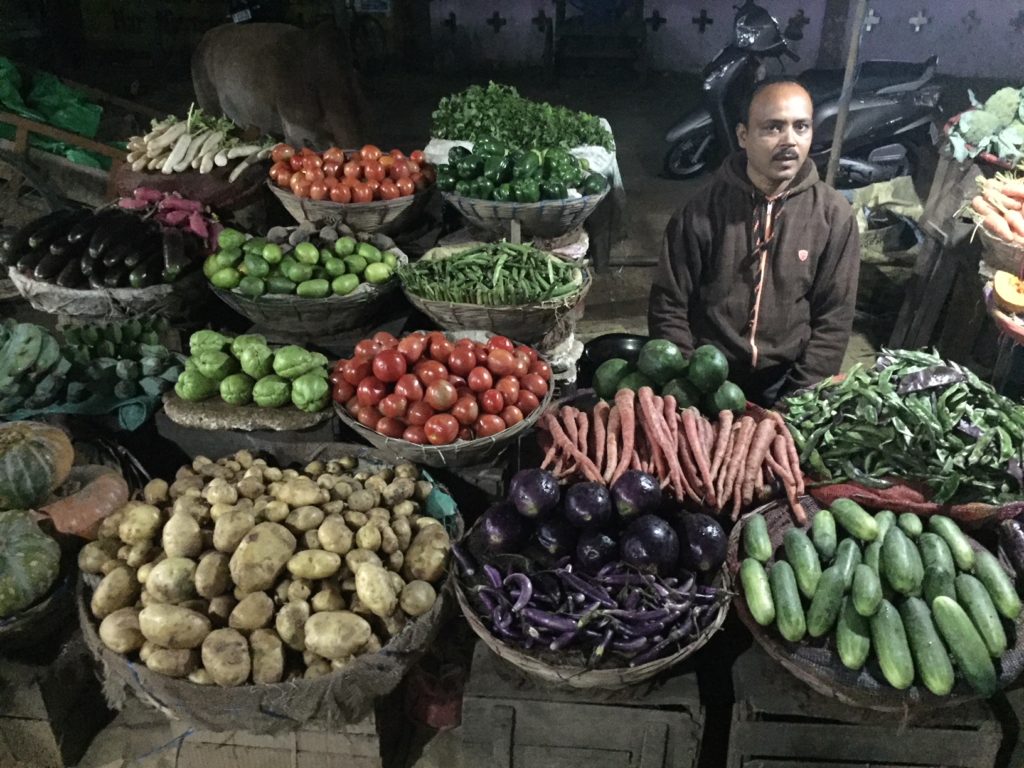
We arrive on a flight from Chennai, around 9pm, find a taxi, and ask the driver to stop when we see a night market on the side of the road. This is our first encounter with Assam. The produce is healthy and plentiful. Baskets filled to the brim with great looking vegetables and fruit. We take advantage to stock up for the next few days.

On our first morning in Assam we discover that we are in what feels like something of a frontier town. Dusty roads, rickshaws, few cars, a quiet languid place. Especially for India.

A corner shrine in blue, an almost abandoned street, and a few vegetable vendors.
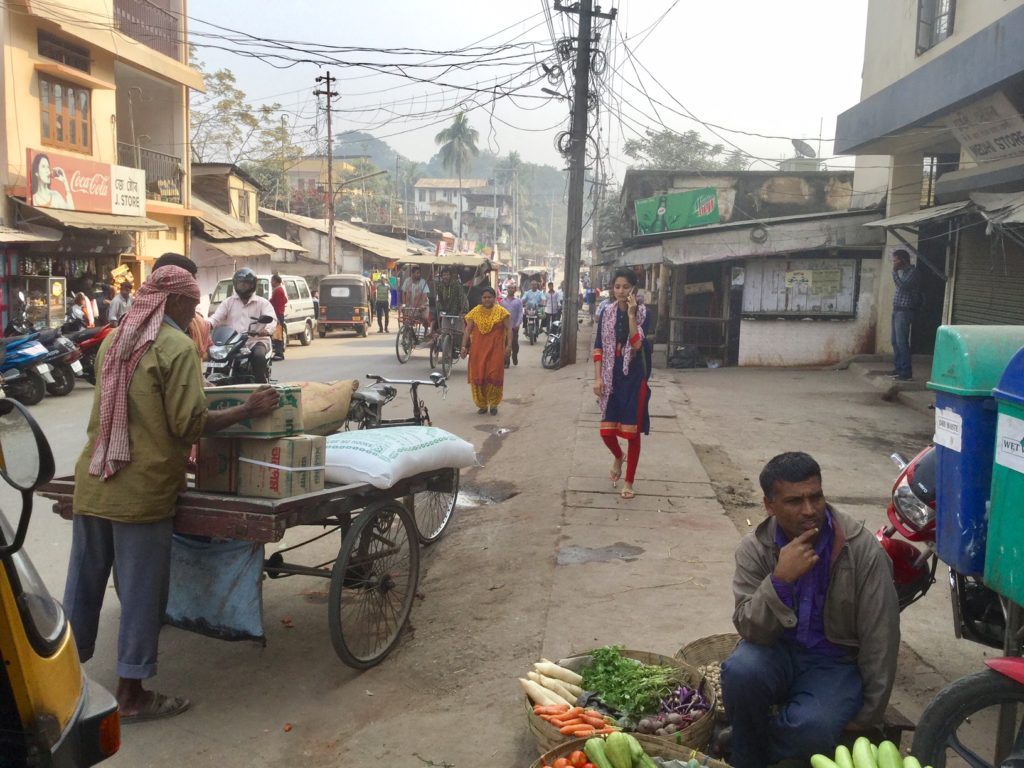
We enjoy watching locals going about the start of the day. We are rather visible as it is clear that foreigners are few and far between in these parts.
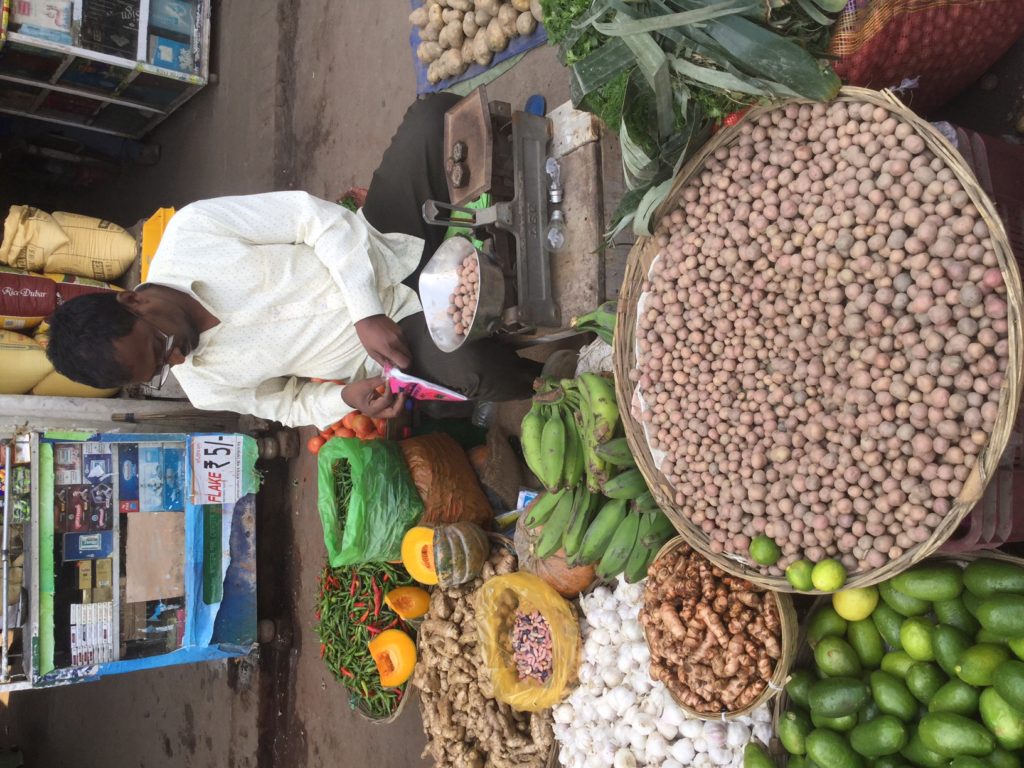
These tiny potatoes, some of them the size of peas, are a fun local root. We bought a bagful of them for two days in a row, and asked our guesthouse cook to roast them for us for dinner. Popcorn size potatoes. Man they were good!!
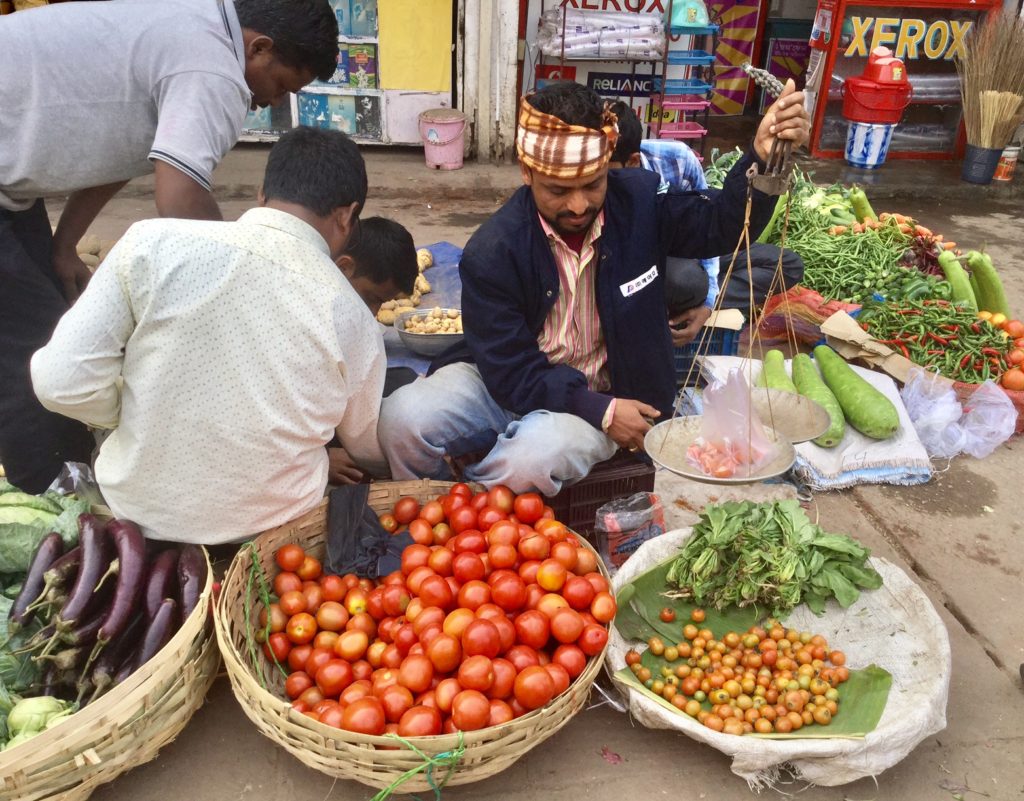
Terrific looking eggplant (again a tiny variety, the size of green beans) and also delicious and great looking tomatoes. The rustic scale is classic. Of course no one speaks English, so the game of pantomime begins.
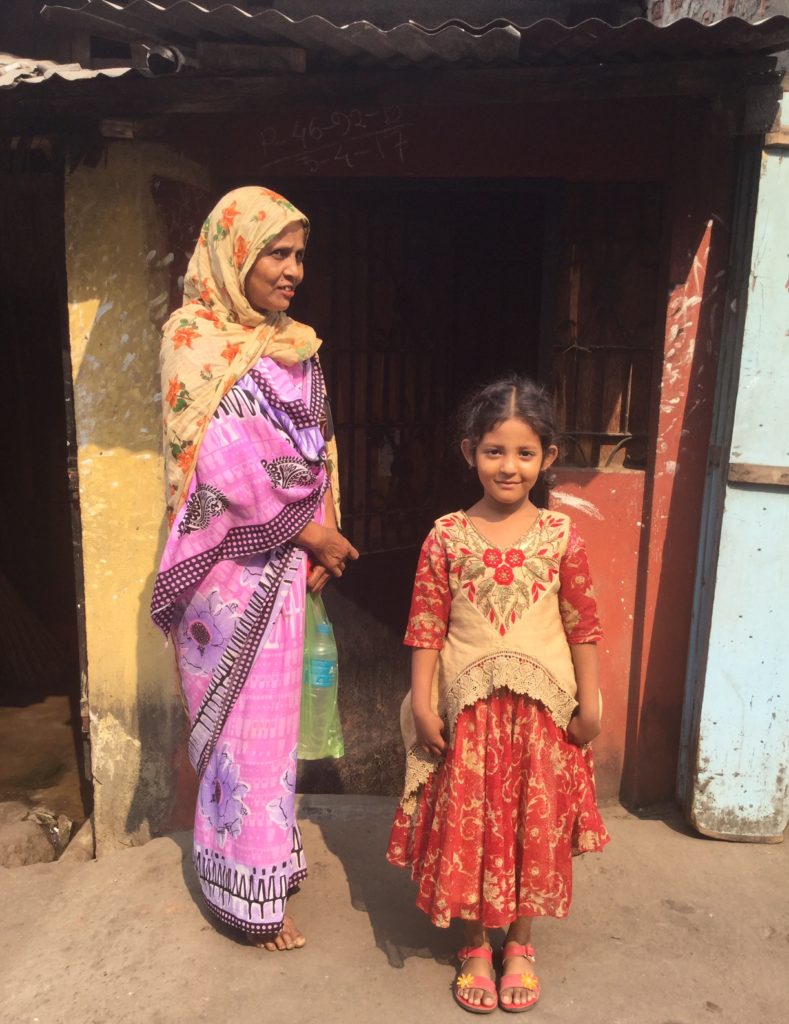
Walking by this mother and her daughter standing outside their front door on the street, the colors of their clothes caught my eye. I asked to take a photo of the little girl, who initially was very shy. After taking the photo she broke out into a huge smile when she saw the photo of herself. This is where I enjoy having an ipad, as the size of the images is helpful in breaking barriers. Second time around she looked right at me and smiled once again for another photo and here it is.
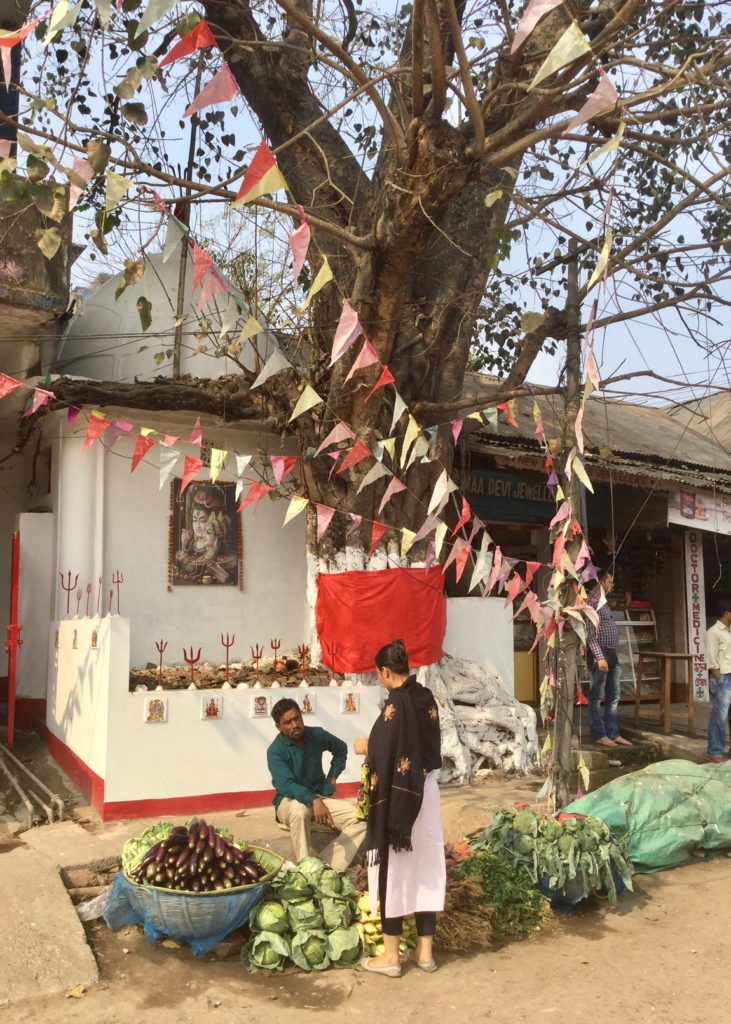
Another small shrine with Tibetan like flags. Behind the vendor the red “pitchforks” are called “trishula“. Ir is a trident that was wielded by the god Shiva and is said to have been used to sever the original head of Ganesha. The three points have various meanings and significance, and, common to Hindu religion, have many stories behind them. They are commonly said to represent various trinities ~ creation, maintenance and destruction; past, present and future. When looked upon as a weapon of Shiva, the trishula is said to destroy the three worlds: the physical world, the world of the forefathers (representing culture drawn from the past) and the world of the mind (representing the processes of sensing and acting).
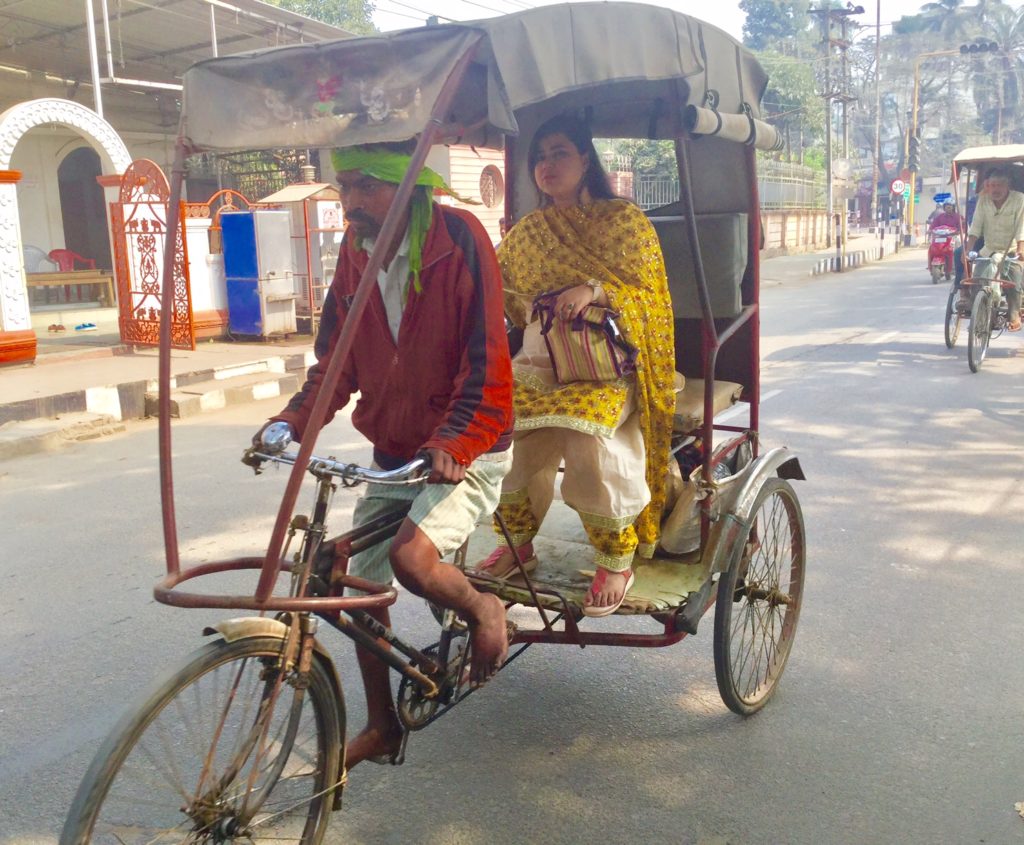
We are headed to an island temple, yet we are in no rush to get there. We take a tuk tuk and get off to find some local breakfast. Rikshaws are the main form of transportation here. They are different from tuk tuks in that they are man powered. To be sure there are other parts of Guwahati that are modern, and have cars and traffic and large shopping malls. This area is more our speed.

Many of the locals here have facial features that appear to be more ethnically related to Tibet in some cases and Burma (Myanmar) in others.
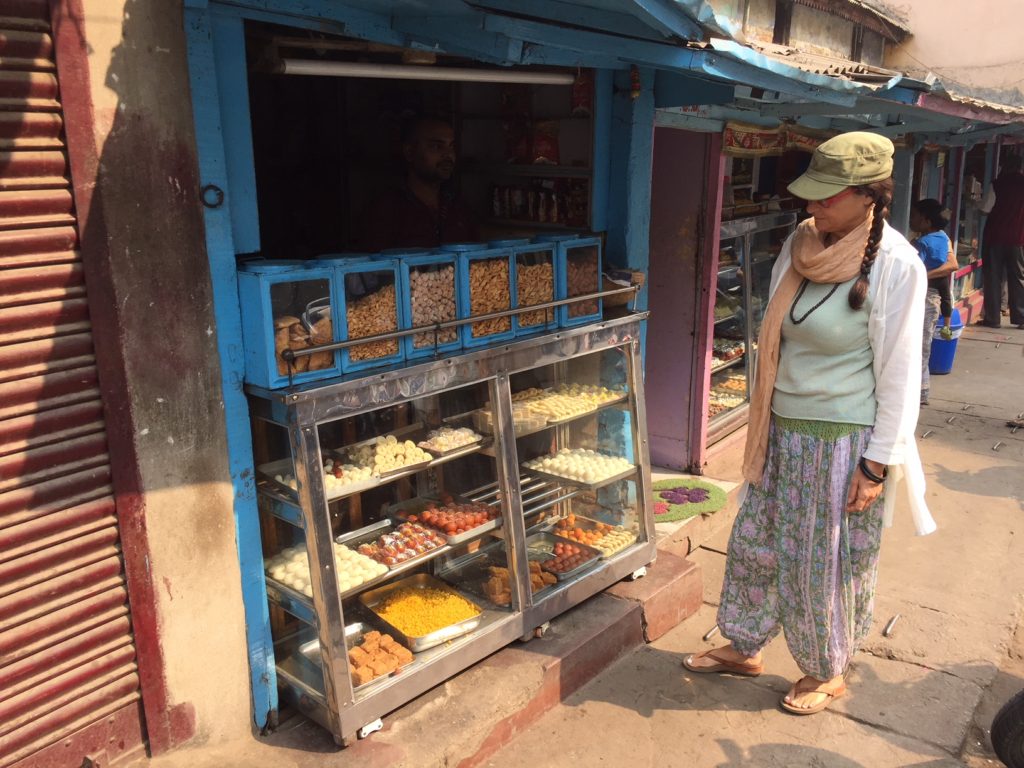
These people take their sweets seriously. This is the first of many shops we see. We tried a few different ones each day. All were delicious, especially the “wet ones” which are made with condensed milk and only available during cooler months, such as now.
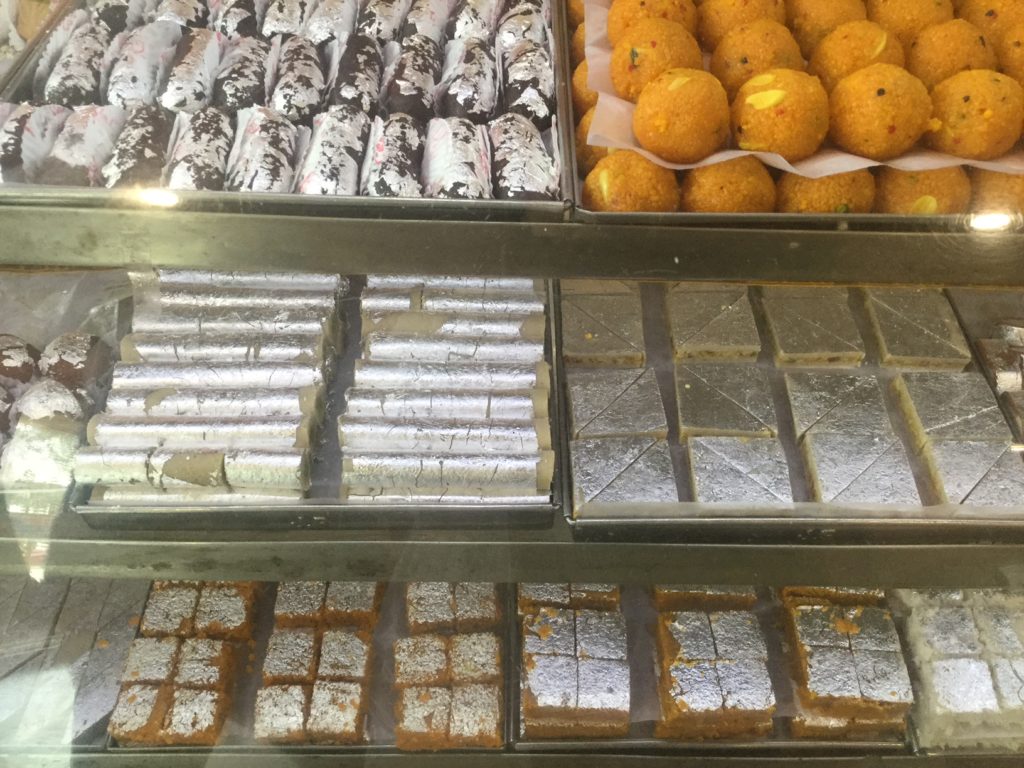
Many of the sweets are covered in an edible silver paper. This makes them even more intriguing and appealing.
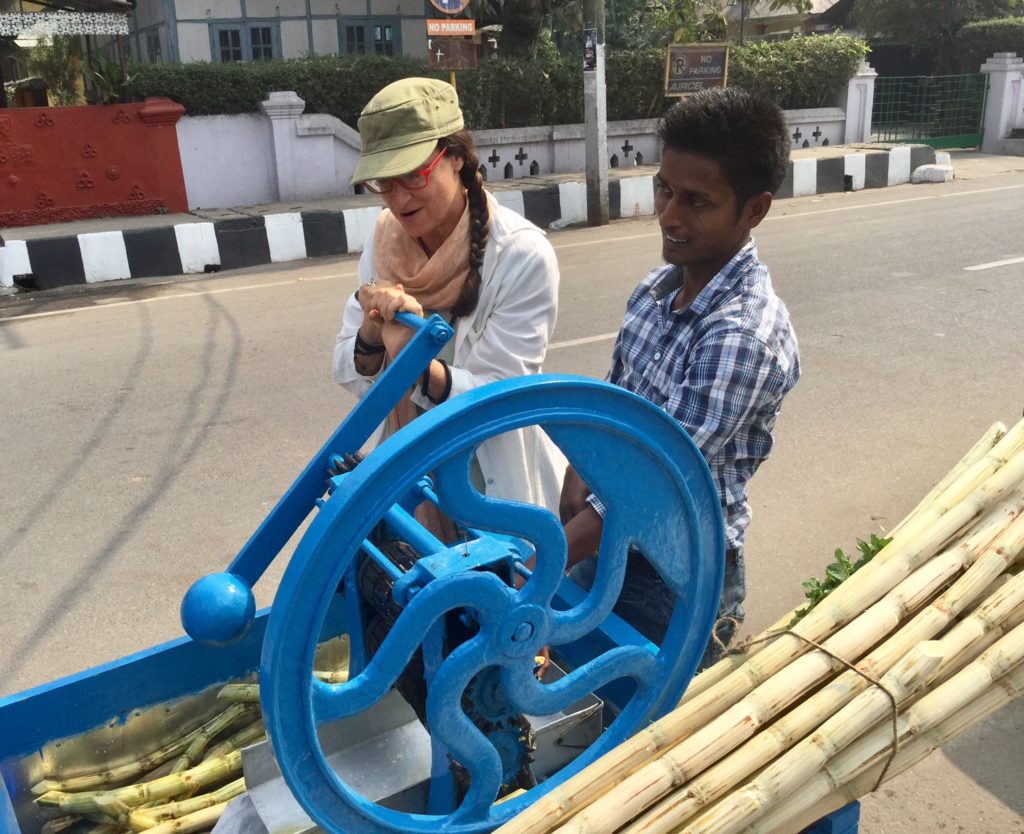
Allright!!! sugarcane juice. Flashback to Viet Nam, where we had this nutritiously valuable and delicious juice all the time.
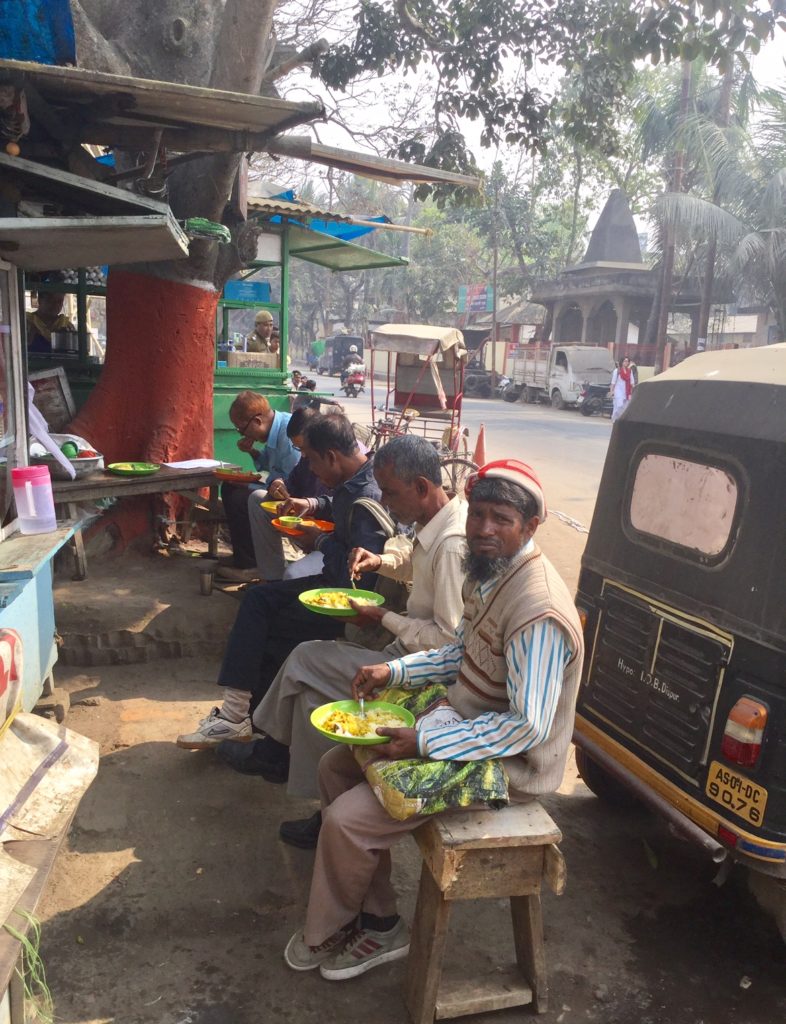
This street corner seems to be a popular street food breakfast spot with the locals… So if they like it, odds are it is worth a try.
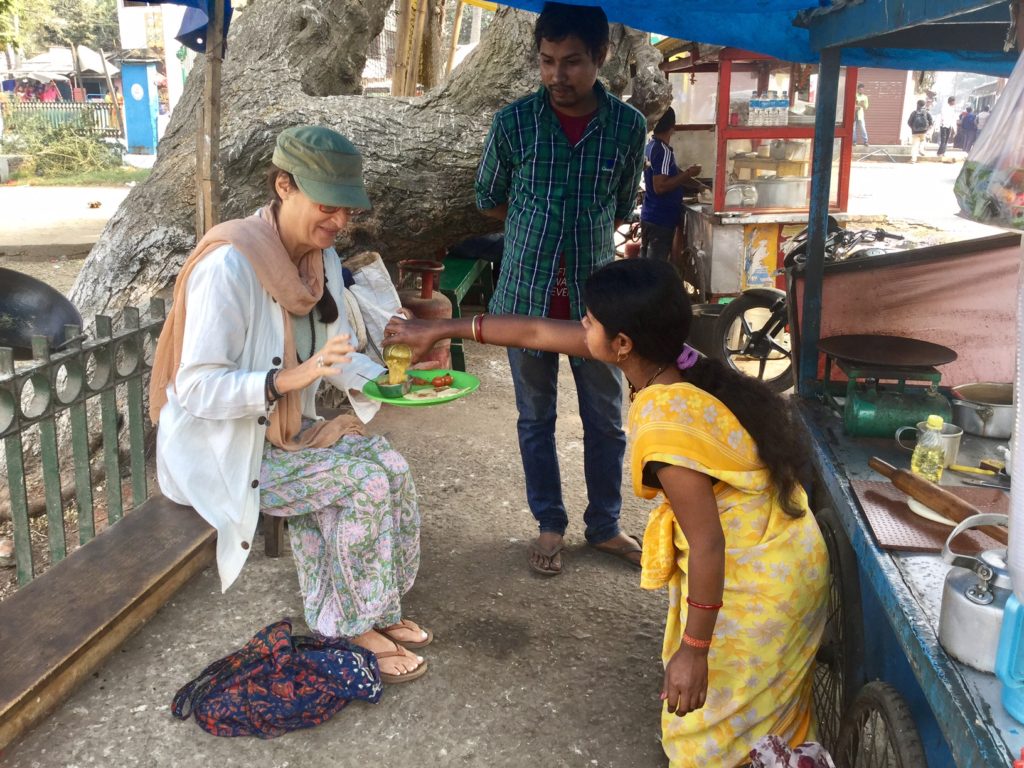
Found breakfast. Fried roti bread with a dahl sauce. Simple but satisfying. Peta is being offered a refill on the dahl.
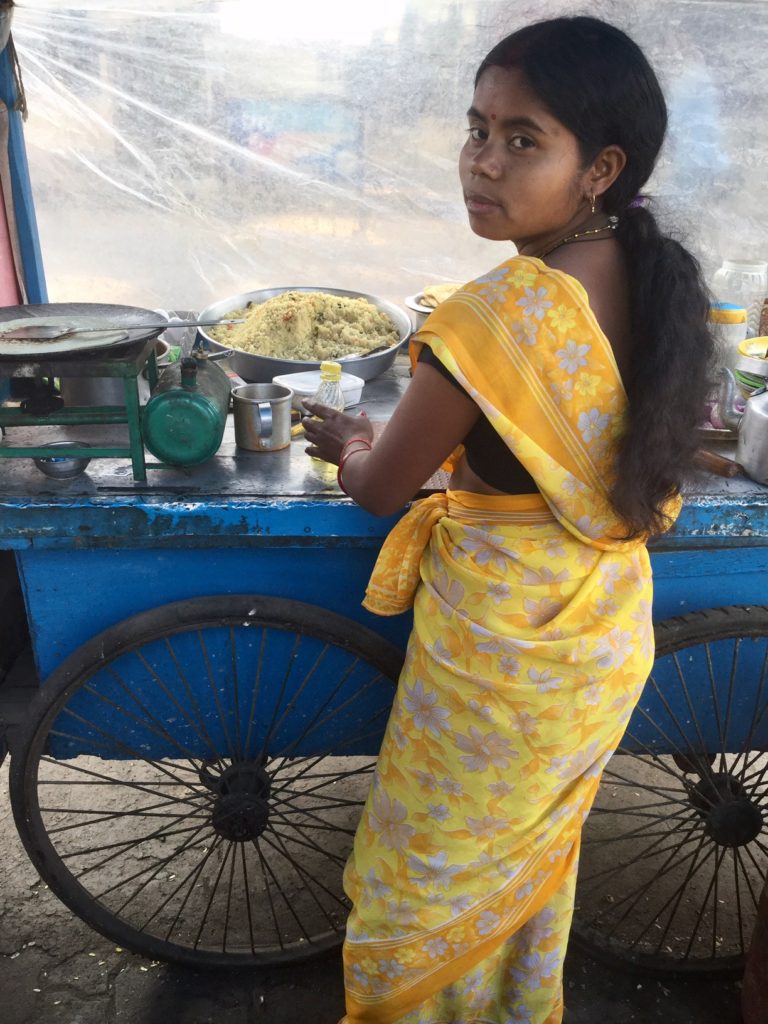
There are quite a few vendors, all making variations of the same food. We deliberately choose this young woman as it seems most of the men are congregating at the male vendor stall. Usually we go for the most crowded when we select street food, but decided to give her our business.
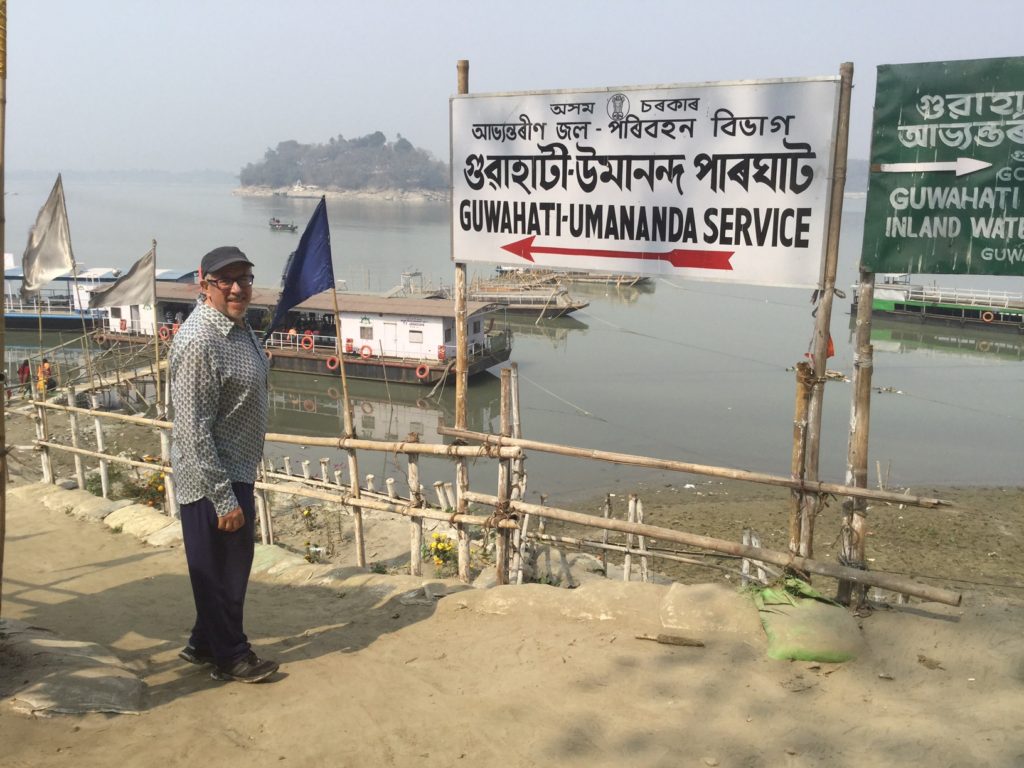
We are about to take a little ferry boat to a small island (in the background) where the temple of Umananda was built.
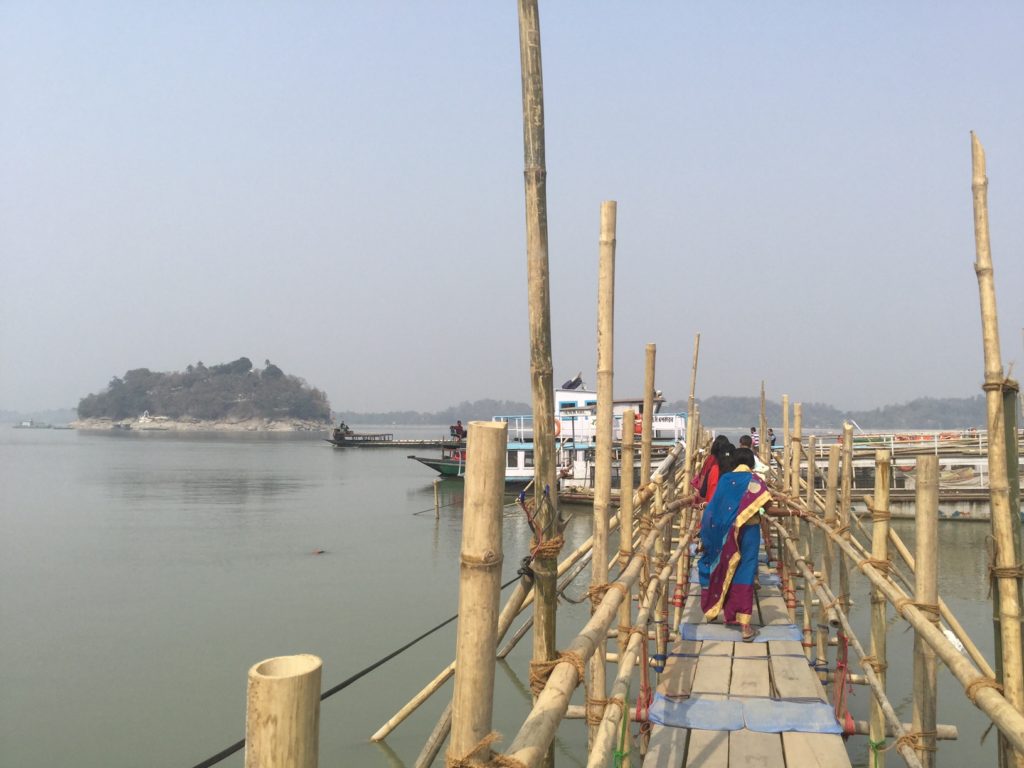
Wooden planks and bamboo rails, and we follow the bright saris to the ferry.
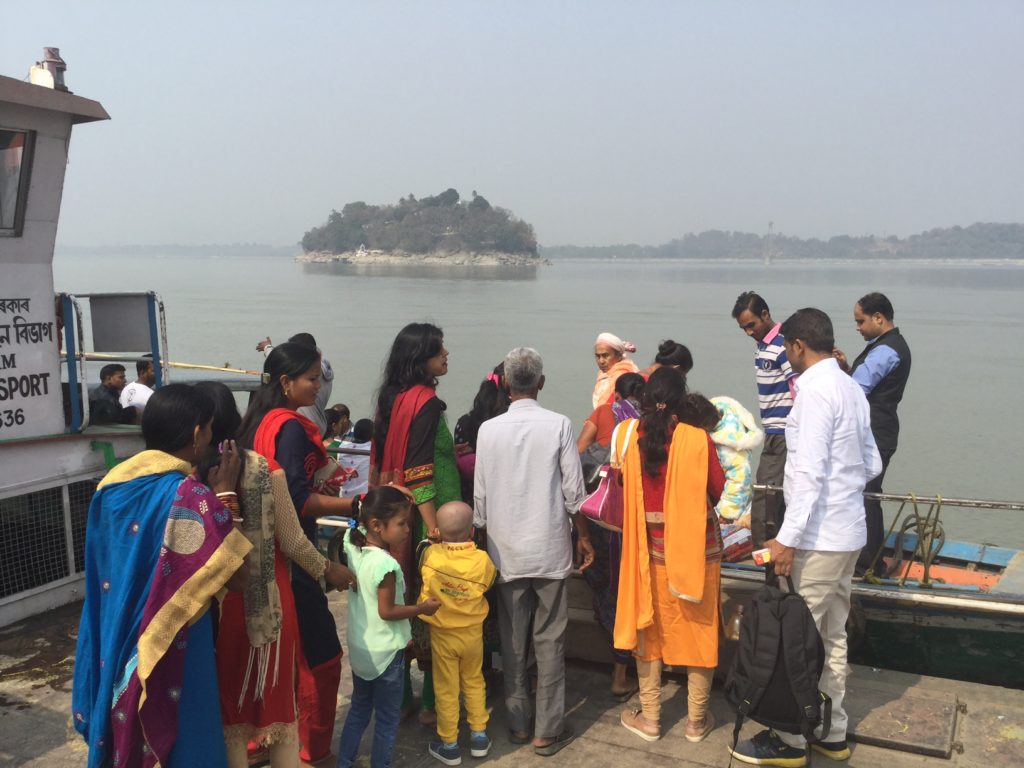
Pilgrims come to Peacock Island in the middle of the river Brahmaputra, the large river indicated in the maps above, all day every day, as this is one of the most worshipped temples of this goddess Shiva.
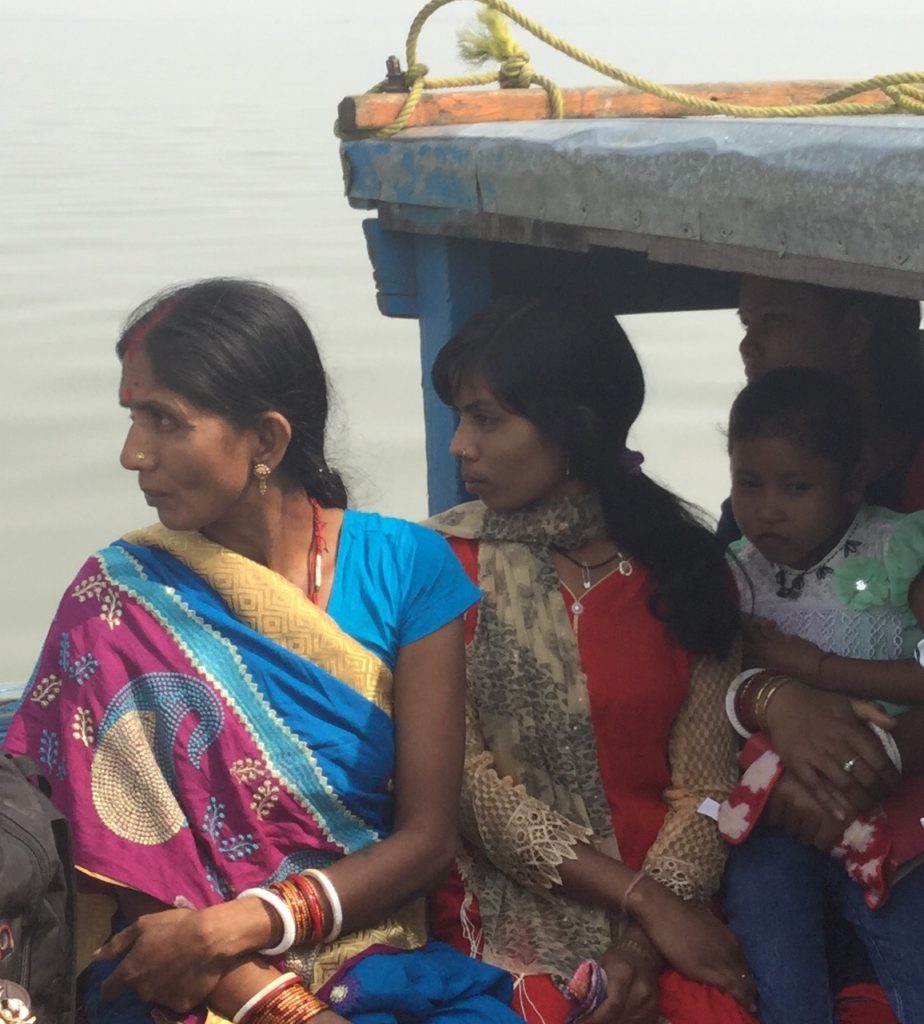 Profile of mother and daughter headed to the temple in the river. Earrings, nose rings, ample bracelets and bright saris adorn most women. A man shows his wealth by his wife’s to the community by the quality and quantity of jewelry his wife wears.
Profile of mother and daughter headed to the temple in the river. Earrings, nose rings, ample bracelets and bright saris adorn most women. A man shows his wealth by his wife’s to the community by the quality and quantity of jewelry his wife wears.
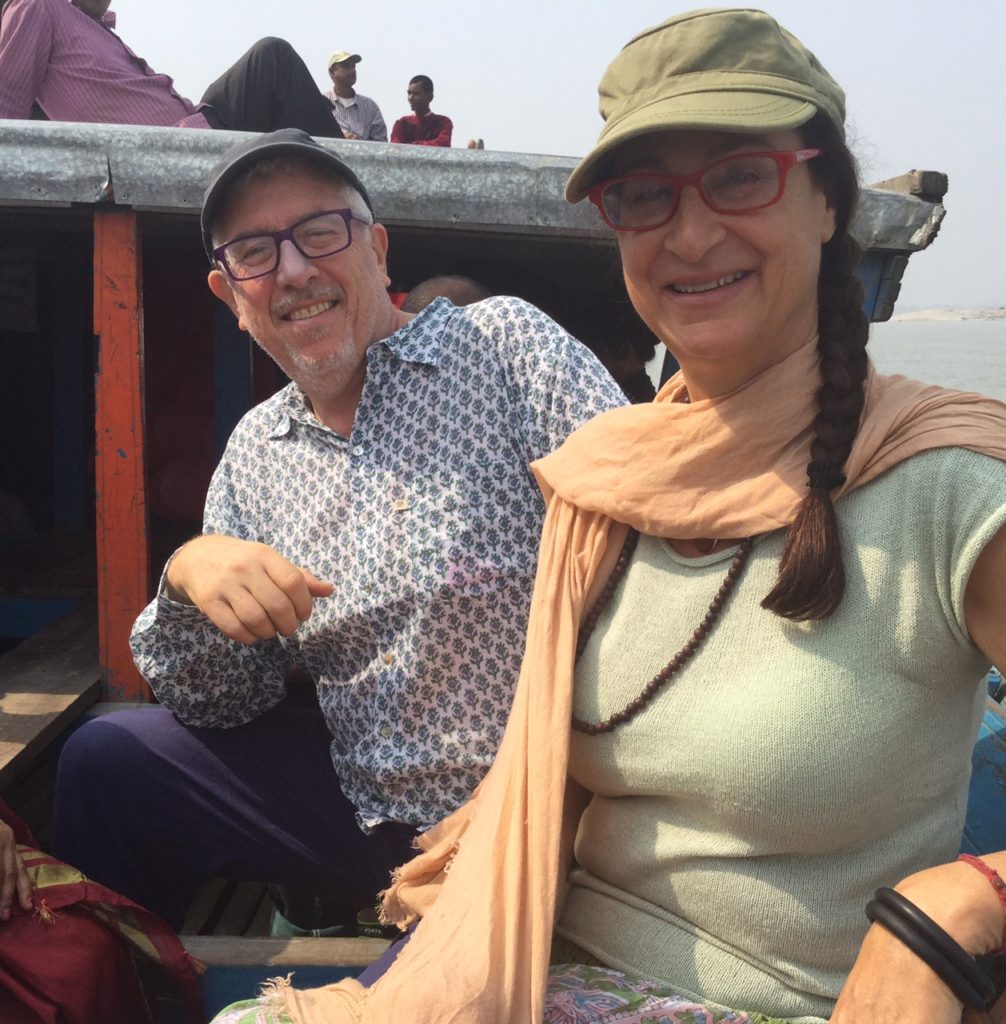
Those that have cell phones are taking photos of the view and of us.
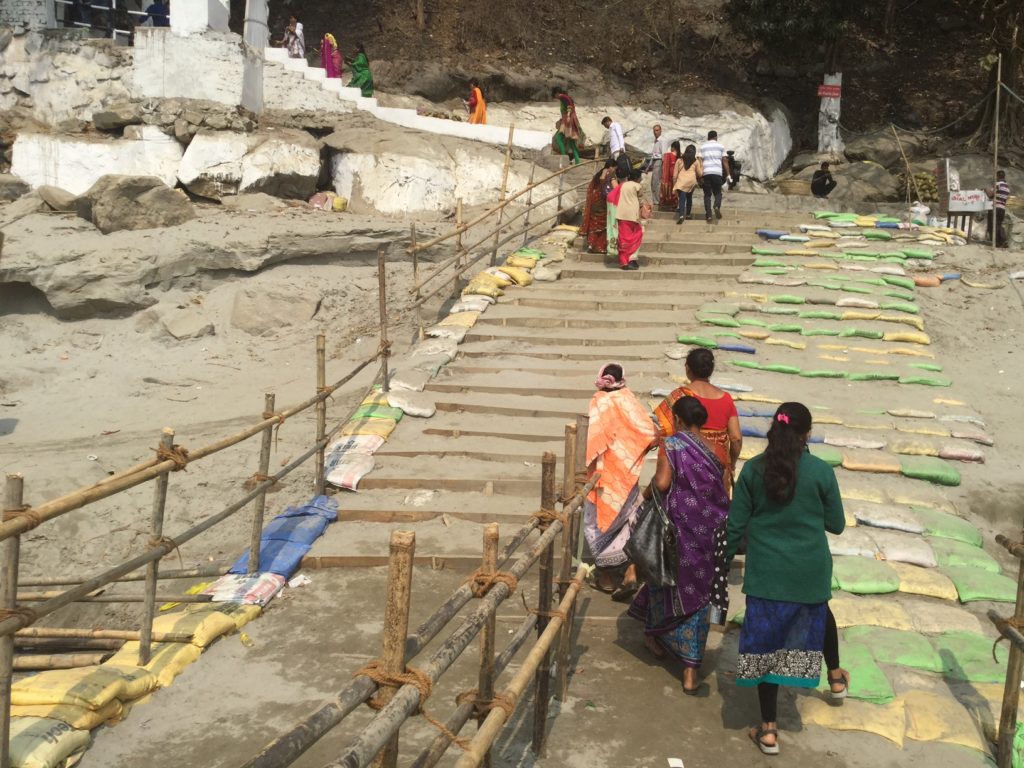
After the ferry docks, it is time to start the climb up the stairs to the top of the island.
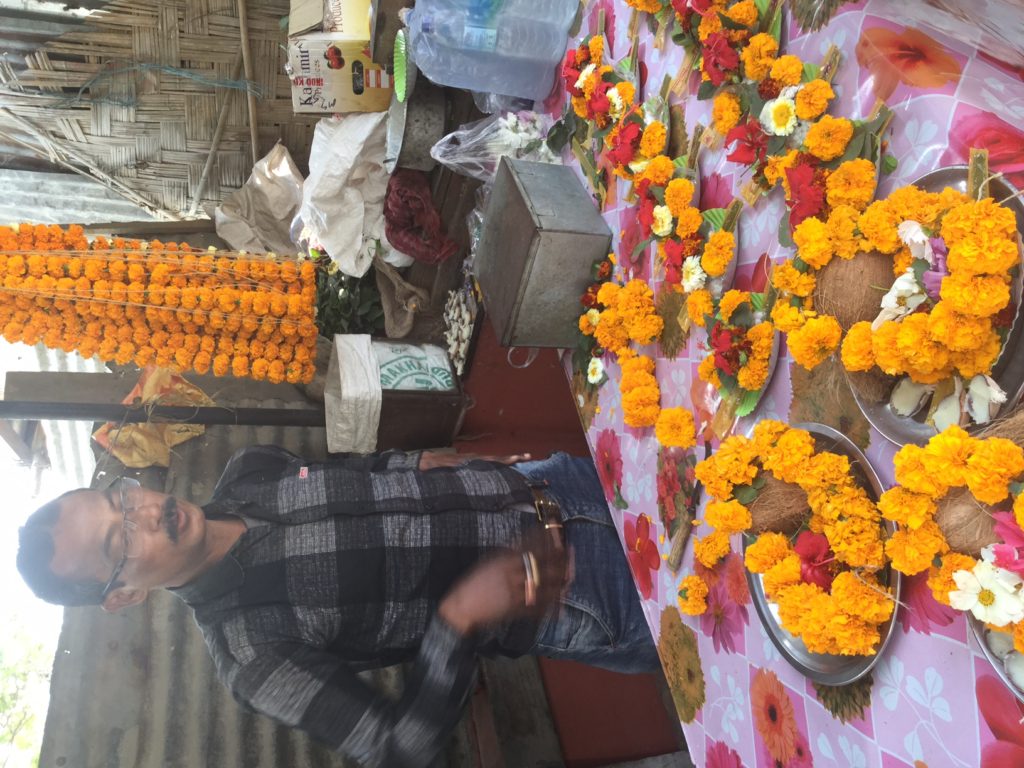
The standard garlands of bright sunflower yellow marigolds for sale outside most Hindu temples.
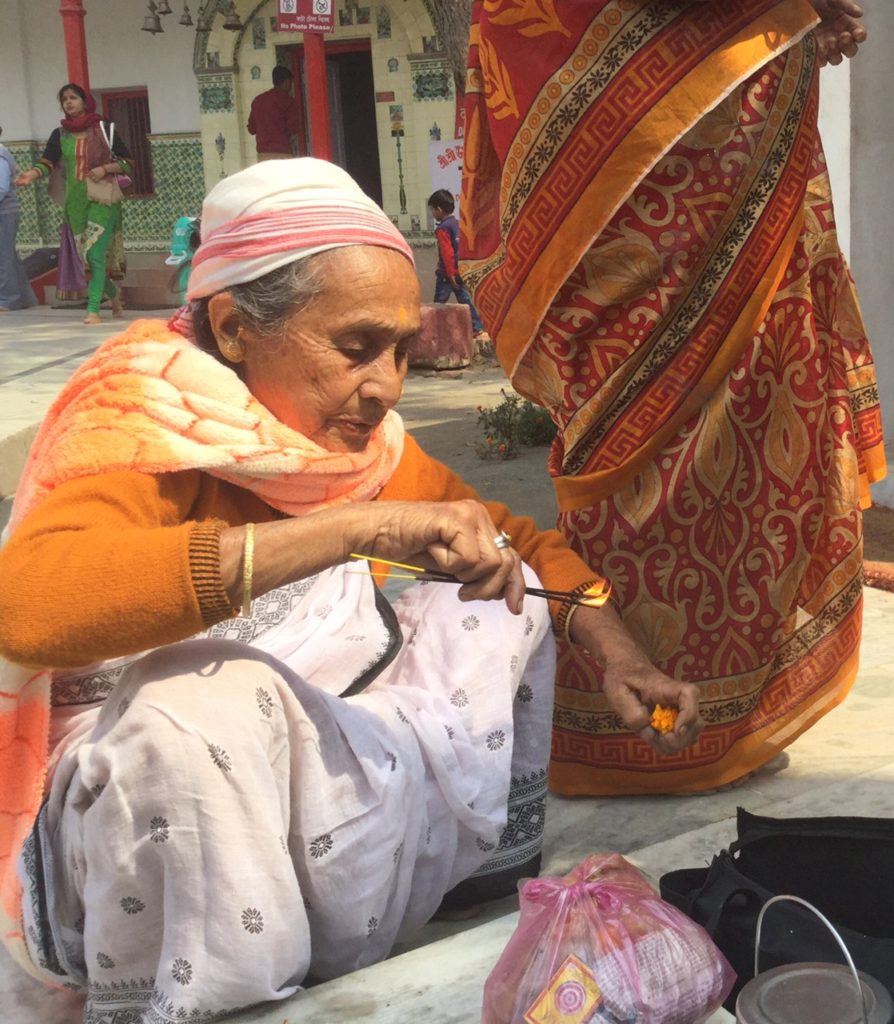
We were sitting next to this elderly woman on the ferry and climbed up the stairs next to her. Her granddaughter speaks a little English and told us that her grandmother is 88. She has come a long way to be able to light incense and pay her respects to Shiva.
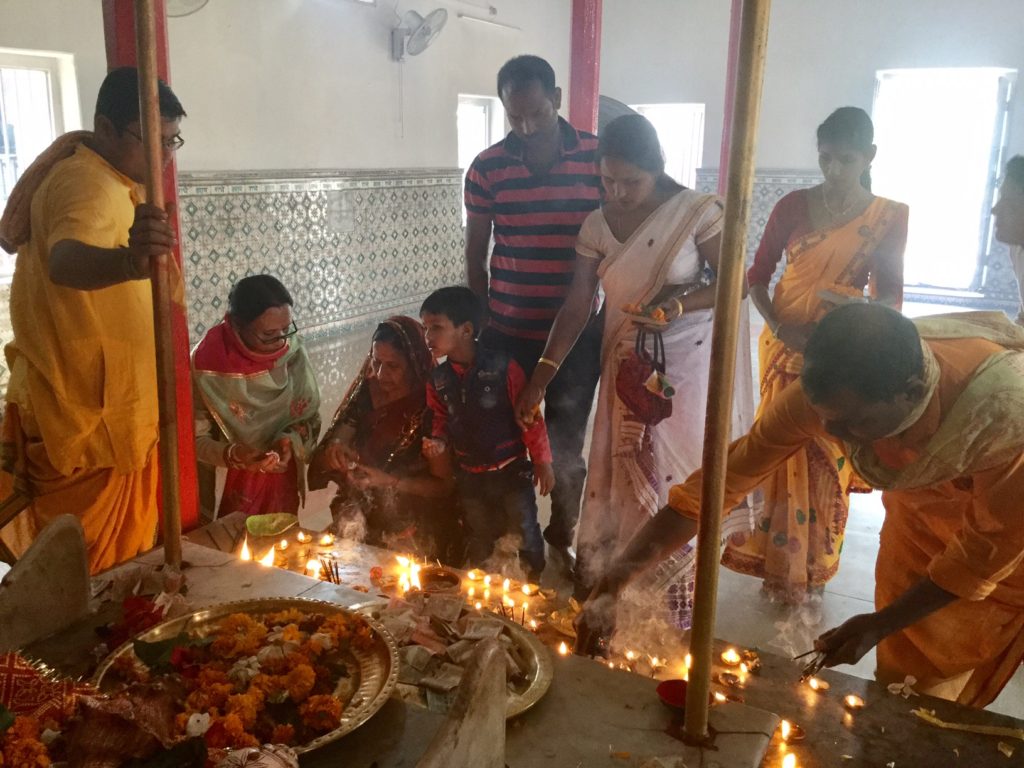
A family gathers around to light the traditional oil lamps and place their flower offerings in front of the gods.
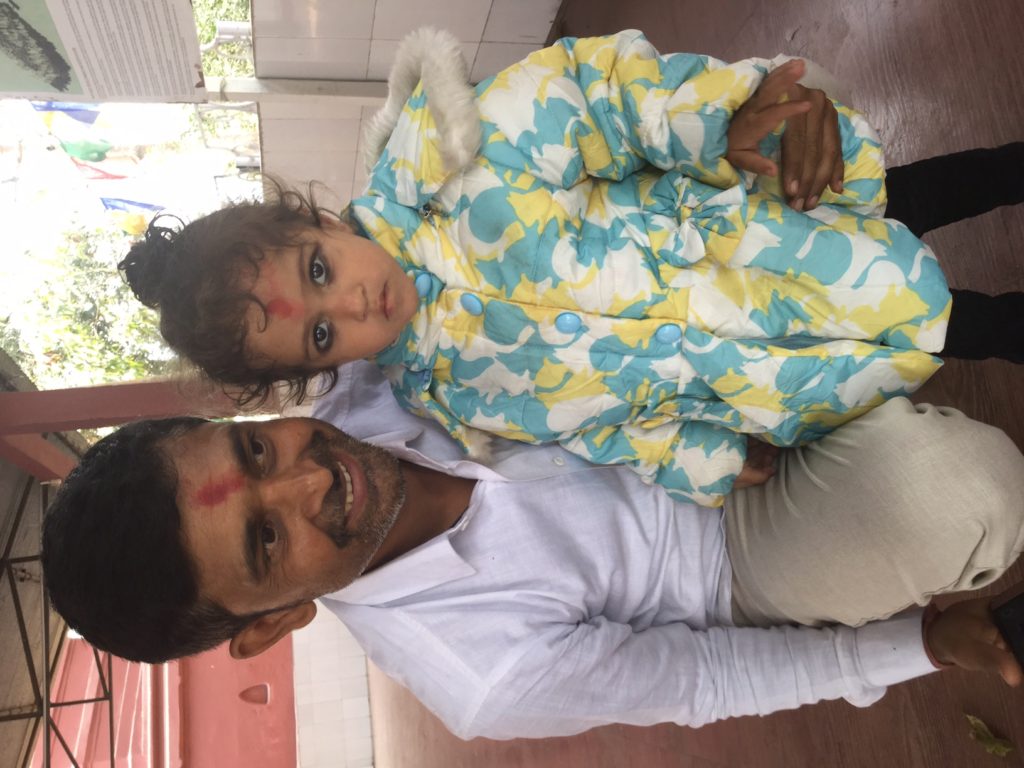
Father and daughter. Starting temple going at a young age. Later on the ferry back, I suggest that the little girl might be too hot in her thick jacket (without language) and off goes the jacket, much to the delight of the sweltering little girl.
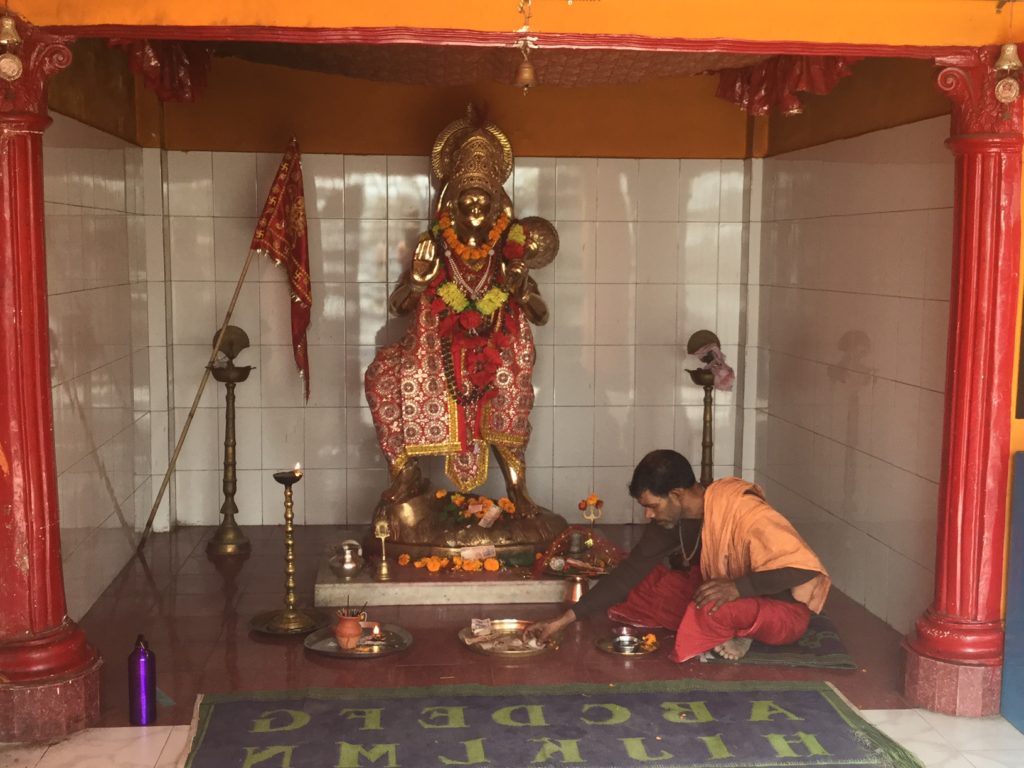
Small side temple dedicated to the monkey god Hanuman one of the most revered gods in the Hindu religion known for his mischievous nature.
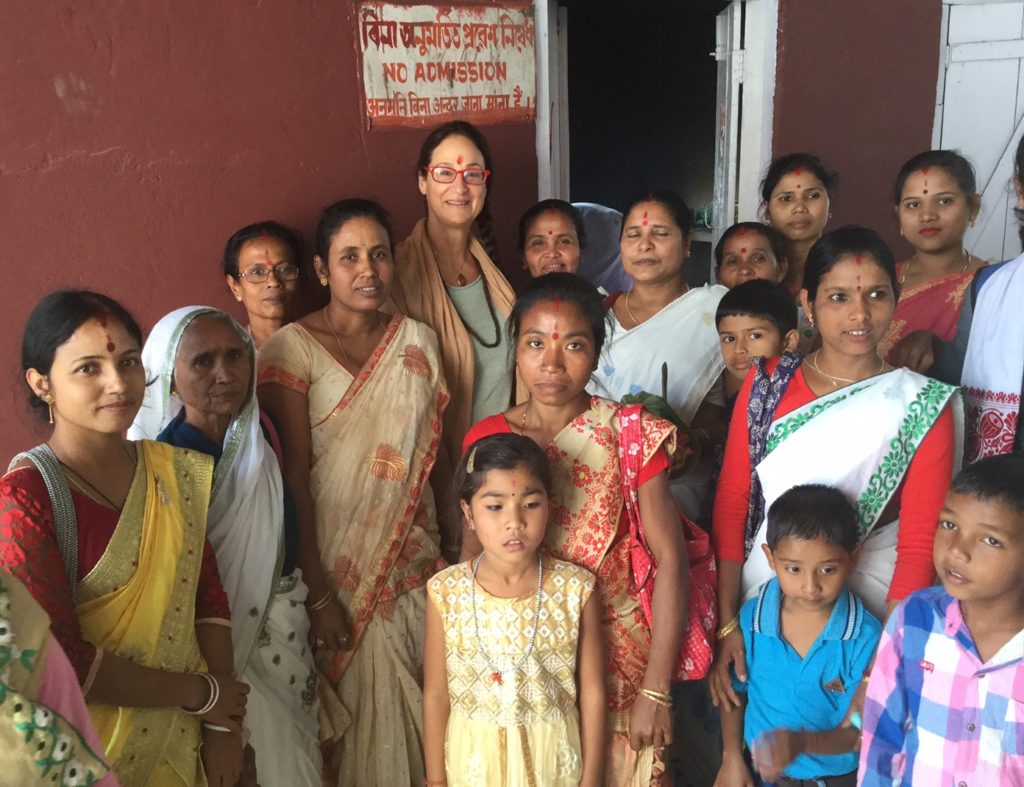
The priest of Hindu temples performs “puja” (rituals and prayers) in the temple. At the end of offering worshippers blessings, the priest applies a red mark on the third eye (between the eyebrows).
The Umananda island temple is considered a “couple” with another Shiva worshipping temple, in fact the largest of its type in all of India. It is the Kamakhya Temple, also in Guwahati.
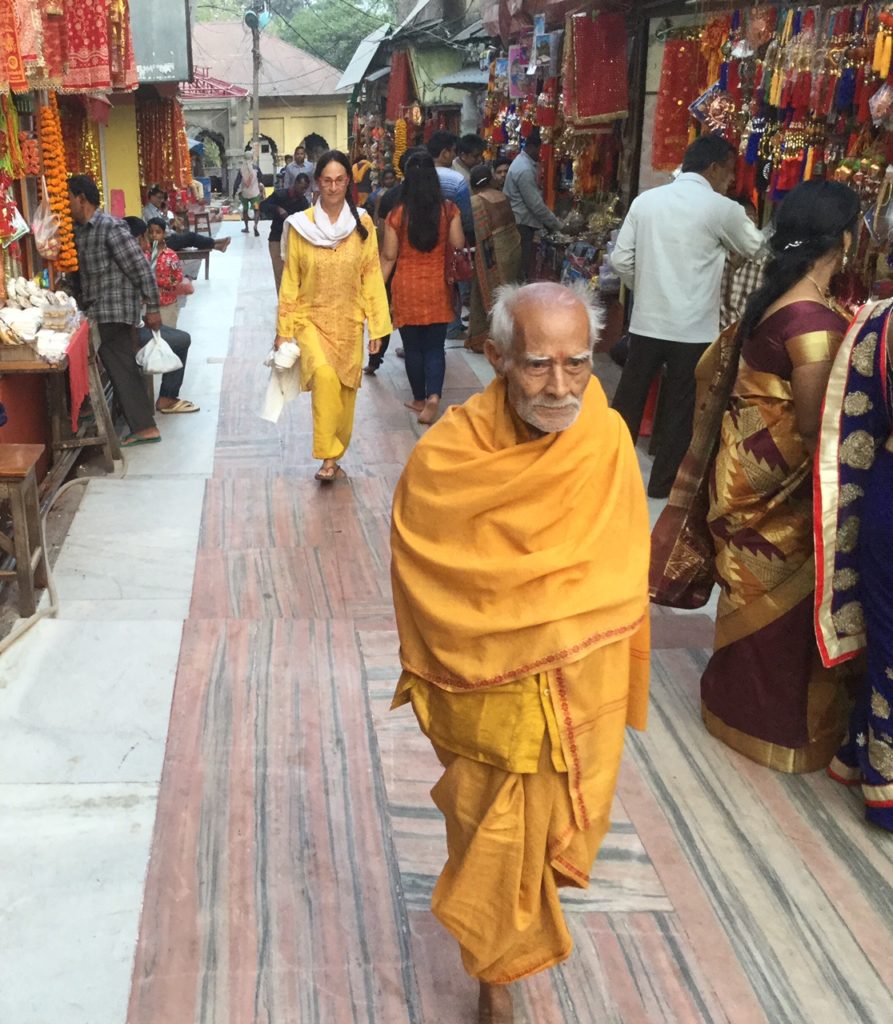
Look at that yellow!
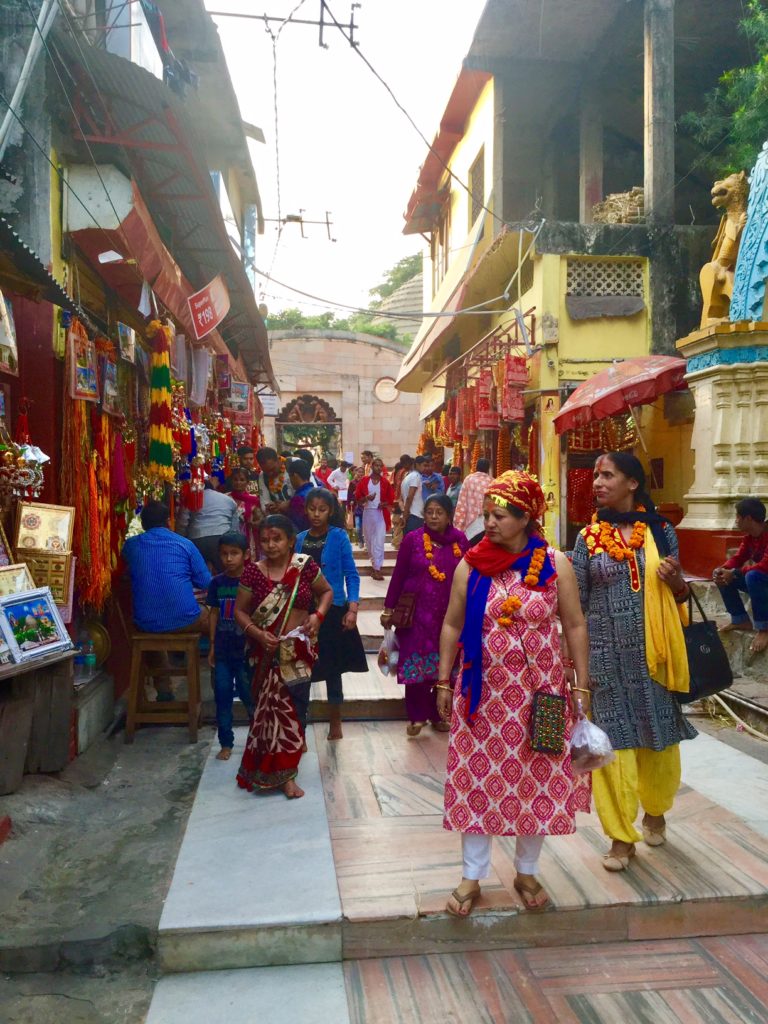
Outside the temple there are a cluster of colorful stores selling temple offerings and decorations for pilgrims. A common scene outside of Hindu temples.
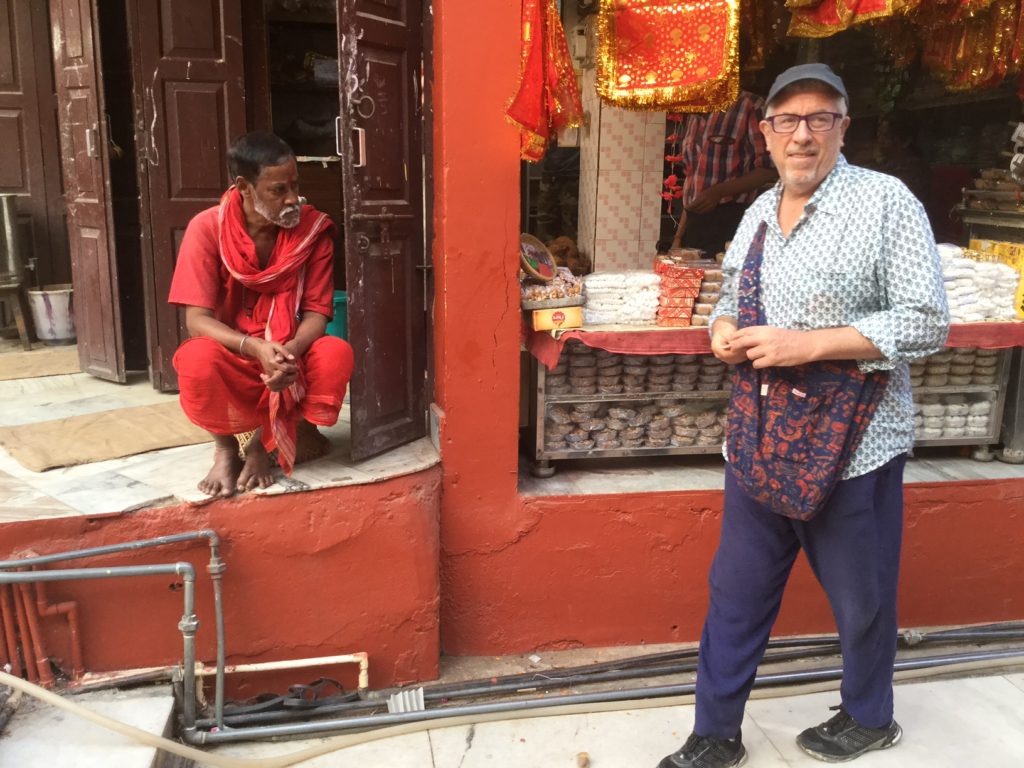
We are soon to discover why there is so much red inside the temple ~ on statues, walls and clothing.

There is something oppressive about this temple. We can’t quite articulate why, but we both pick up a negative energy and are keen to get out of there quickly. Turns out that there is a long and complex story about Shiva’s fury, a goddess being killed and chopped up in pieces with each piece delivered across the country of India and this temple got the vagina as the goddess’s body part. It is in fact known as the temple of the Bleeding Goddess. Many of the stories have to do with menstruation and the continued practice of animal sacrifices. Many of the statues are painted blood red. Definitely a creepy place, to us.
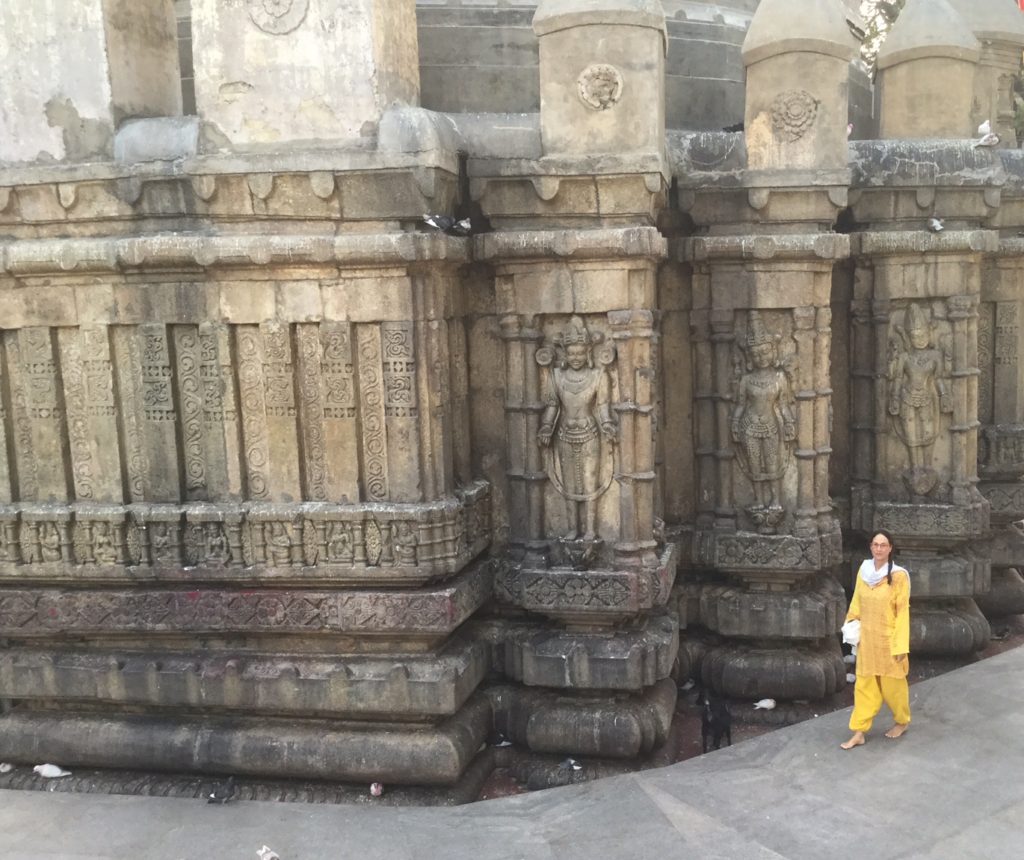
The walls of the main temple are huge and contain many interesting sculptures on them. The lower part of the walls were full of pigeons nesting in them.
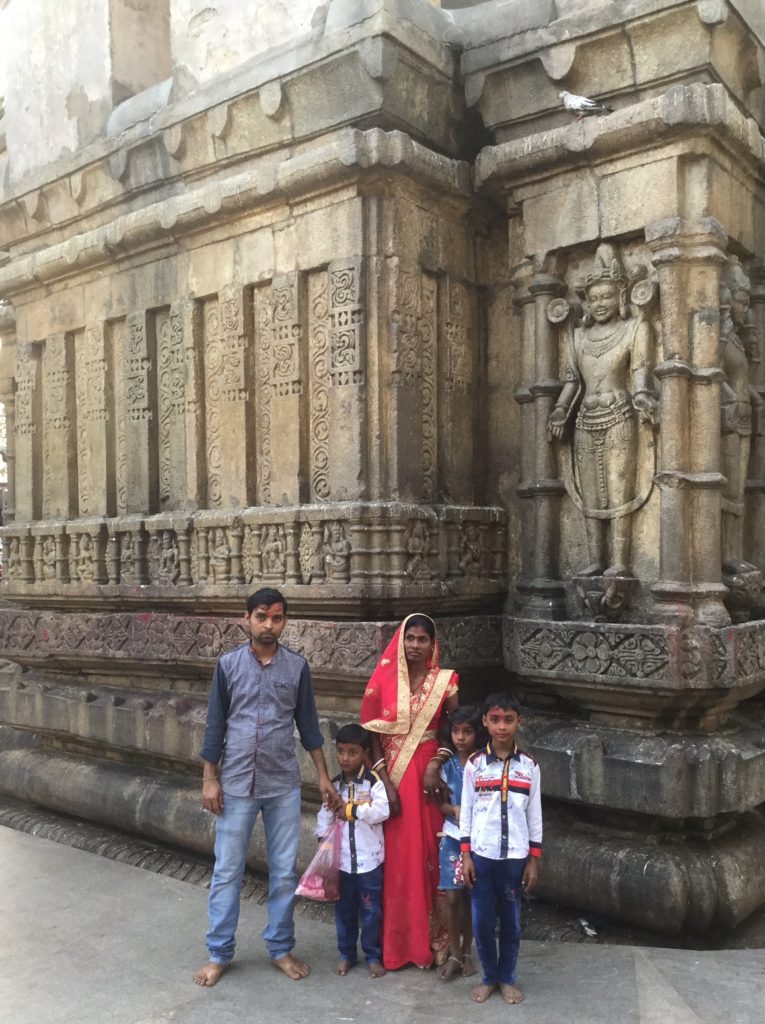
A young family poses for a family temple portrait.
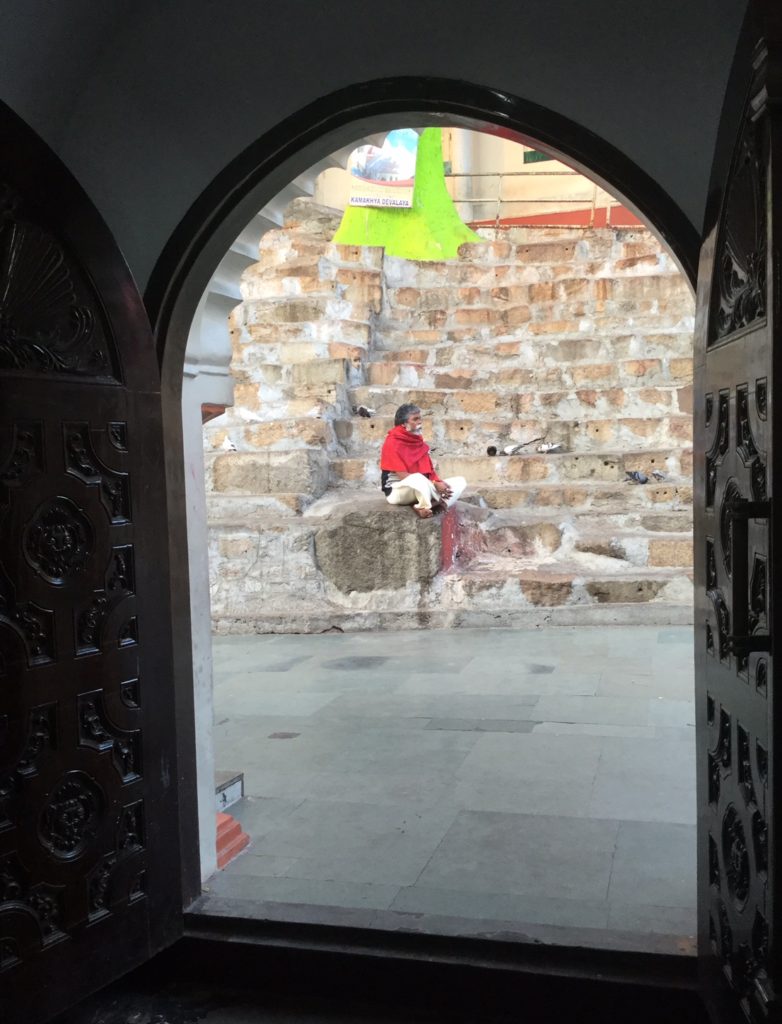
We have no desire to get into the depth of this temple structure. We walk quickly through, avoiding the dark chambers where pilgrims are waiting in lines to be blessed and pay respect to the Bleeding Goddess. The passageways are dark and oppressive.
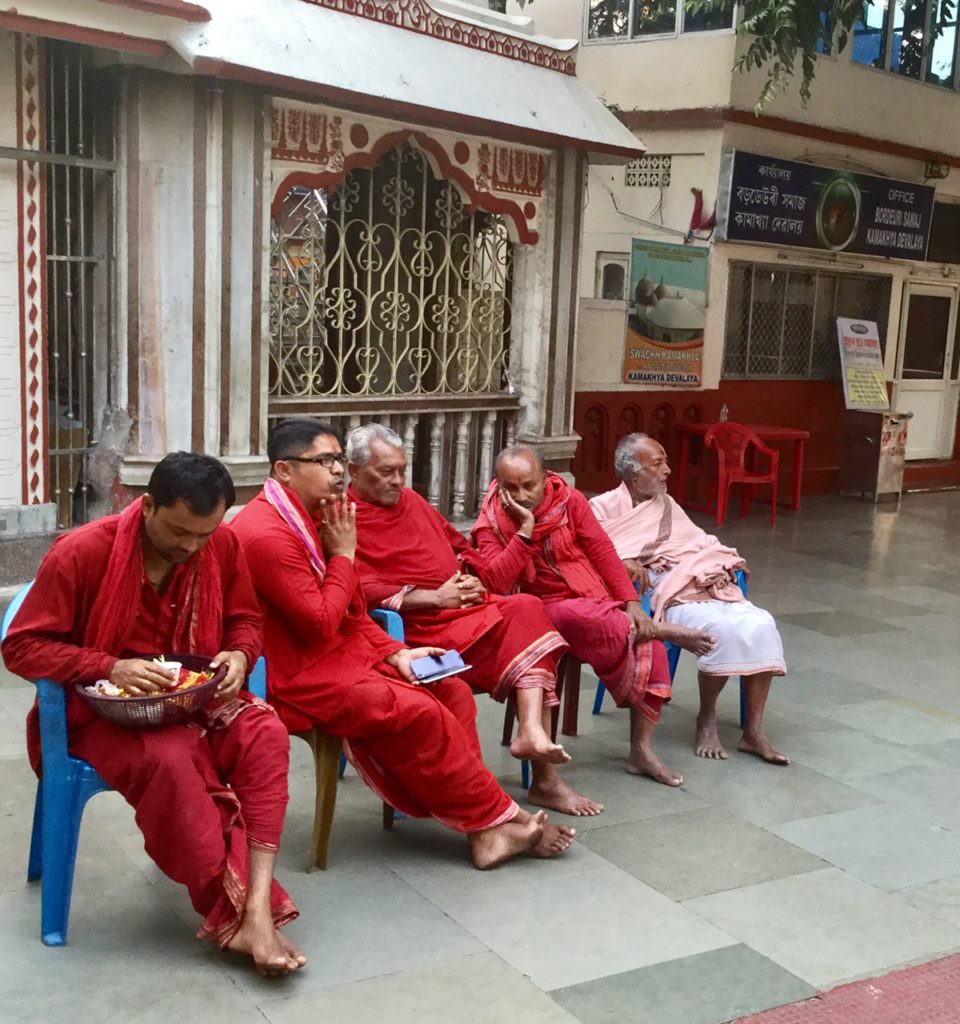
Priests in red, taking a break.
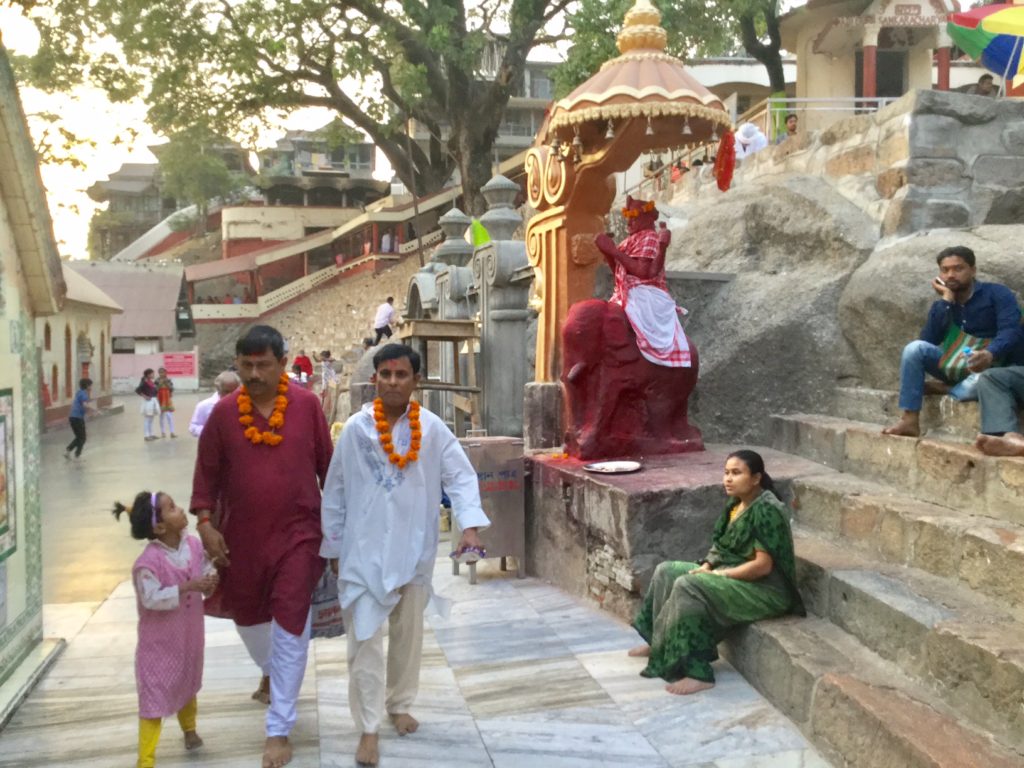
There is usually a joyous feel to an Indian temple, but not this one.
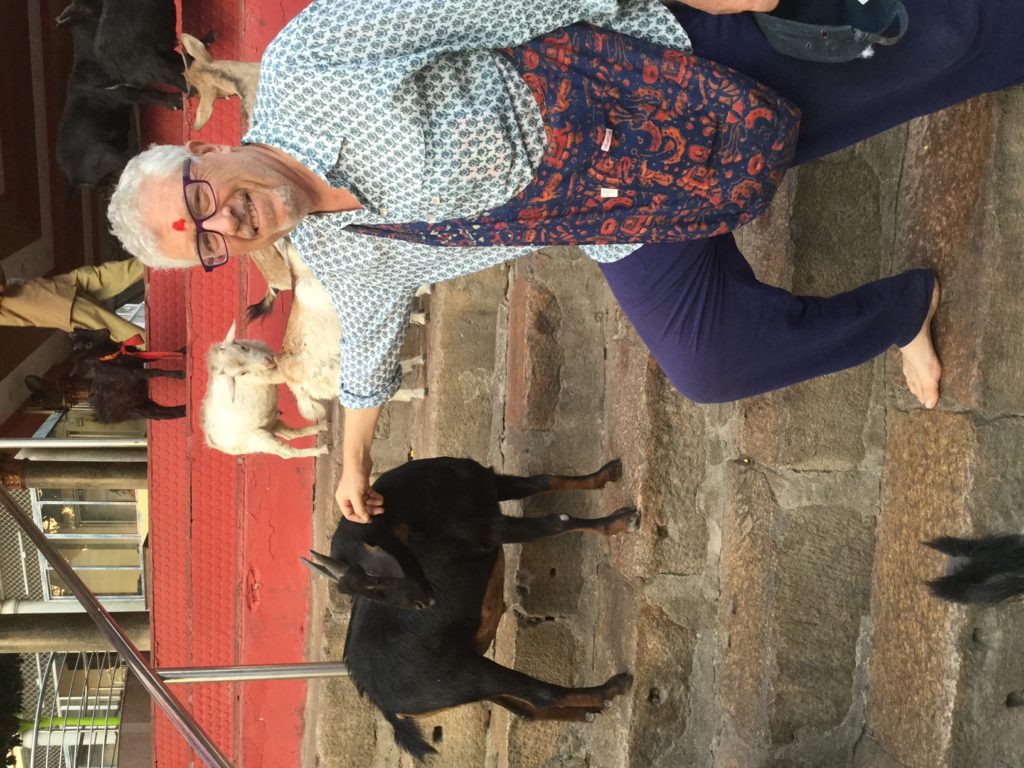
There are quite a few goats milling around, not sure if they are the ones that will be used for sacrifice and we are keen to find out….

Suddenly this unusually large and very strange looking goat runs (gallops) up the steps and passes us in a flash. Check out the expression of the girl on the far left, closest to the animal.
Our first couple of days in Assam were indeed quite an adventure. From frontier town dusty roads and impromptu breakfast, to a ferry boat ride with friendly locals, to a short segue to the dark side where animal sacrifices continue to be the norm.
As Mark Twain wrote: “Travel is fatal to prejudice, bigotry and narrow-mindedness”. Even when our Green Global Trek takes us to places that engender discomfort, such as this last temple, there is always something to learn about cultural and religious practices that broaden our understanding of the small but richly complex world we live in.
I have always wanted to go to Assam. This region is the only place in India to where apes are native: the hoolock gibbon!! So glad you’re both out there. Loved the political insights, Ben. And love you both tons.
Wish we had known about the hoolock gibbon!!!! However, we did get to see the one horned rhino…(coming up next). The political insight may not be everyone’s cup of tea but not a surprise you would appreciate it 🙂 Love you both too!!!
xoxo
P&B
What an amazing experience. I loved travelling to Assam with the two of you. Love the yellow!!
Thanks Darlene, glad you enjoyed Assam with us. Thanks for commenting on the yellow. Ben’s new favorite color!
Peta
Enjoyed both parts of this post. Thanks, friends.
Thanks for reading, glad you enjoyed the political as well as the street and temple scenes.
Peta
Another fascinating post. I hadn’t really grasped before how narrow the link was between this NE part of India and the “mainland”.
Anabel, nor had we. Most people are totally unaware of this part of India. We were not.. until we read about it while doing some research ahead of time. Isn’t it incredible from a geographic point of view?! The narrow entry point into the Seven Sisters, States of the Northeast, is only 20 kms wide!
Glad you enjoyed reading this post.
Peta & Ben
Thanks for the memories. We were in Assam less than two years ago. It is a different India.
Nice to hear of someone else that has actually been to Assam. Will go and check out your archives. Thanks
Peta
This is so interesting…..keep exploring, photographing and writing…I am traveling with you in my mind and my heart.
💜💙💚
Madame Bell, so happy to know you found this post interesting!! We often think of you in various places and rate them according them to “how unlikely would it be that JB would want to visit here?!” Love you xoxox
Bisous
P&B
Great read and wonderful pictures! As a fellow empty nester, I look forward to following your adventures.
Thanks Julie. Welcome to Green Global Trek, our now ten year long empty nester adventure. Have fun looking through the archives 🙂
Peta & Ben
This post is fascinating, Ben and Peta – the background story as well as the travelogue and photos. I wasn’t even aware (or forgot) about this part of India, to be honest. Ignorant, I know. That being out of the way, I agree with there being different Indias. Delhi is probably comparable to Calcutta, especially the slums in the old part. And, during my five weeks in the country, many, many years ago, I also visited an area close to Nepal, in the mountains, where Buddhism was a big part of life. The temperature, atmosphere, sites and people were very different there than in Rajasthan and New Delhi. I certainly felt more at ease. Traveling is definitely “expanding our horizons”. 🙂
Thanks for your thoughtful comments Liesbet. Most people are definitely not aware of this part of India, it was only through research that we came across it and were instantly fascinated and eager to visit. India more than anywhere perhaps, is a land of contrasts, as you know. The complexity and richness and mind boggling layers of geographic, ethnic, cultural components makes India discovery a work in progress for anyone no matter how many visits or how long one stays.
Peta & Ben
Having never been to India your post stirs my wanderlust. But where to start? I think I should want you as my personal guides! Assam seems like an extraordinary area to explore. Loved following along with you.
Ah, India awaits you. Once you travel there, everything else will seem rather bland in comparison 🙂 Starting in somewhere like Pondicherry (2 blog posts back) would be a decent “soft landing” rather than say, Delhi which is a huge shock for most. The larger cities can definitely be overwhelming. You might enjoy taking a spin through our archives on India in case you haven’t seen those yet… to get different vignettes of India.
Thanks for the lovely feedback.
Peta & Ben
This place is like a different planet. Seriously.
Amazing.
Beautiful.
The colors. Oh, My. The vegetables. Those little potatoes are thrilling.
Except the creep place w/ blood red paint on the walls.
You are living your life & bringing us w/ you!
In appreciation from Duluth! x
Kim, one can imagine if any people from Assam were to visit Duluth, they might say the same thing 🙂 Many different life realities occurring simultaneously, it just depends where one puts the pin on the map.
So glad you enjoyed this post, except for the Kamakhya Temple, of course…
P&B
Jumping back a few years, I would have had no solid knowledge of this area squeezed out of the northeast of India. Oddly, I got to know quite a bit about it when we met a couple, originally from Chicago, who moved to Shillong and started two businesses (a remote/virtual writing company and a nascent spice company). Since then, we’ve had occasion to hear about this region more than once – and now again from you! When I win the lottery and can travel non-stop, this and the many other Indias will be on my itinerary!
Lex most people are unaware of this little piece of India in the remote North East corner. Interesting to hear of Chicagoans who moved to Shillong! Do they still live there?
You definitely do not have to wait till you “win the lottery” for a trip to India. If you can find the time and patience for the long flight and splurge on the ticket, after that india is very inexpensive in comparison to traveling to Europe etc. We do it on quite a low budget, but of course the flight from Sri Lanka is quick and cheap.
Ben & Peta
GREAT POST! Thanks for the Benipedia – lots of interesting facts and perspectives I was not aware of at all. Pictures were fantabulous – I so like how you capture the people not just the place.
Alas, I’m saddened to see that Ben isn’t doing very well financially – Not one nose ring, bracelet or opulent attire on Peta. Her glasses aren’t even studded in gold.
THANKS Judith for the compliments. “Benipedia”, an apt concept. I have no idea how he remembers all that history and geography!
For us, it is very much the people who make the place memorable. Sad to say Judith your observation is pretty accurate for right now. I did buy two ankle bracelets but they don’t show in the pictures. They were about $1 each, so not sure they qualify…
Peta
Very informative! I wonder if I’m losing my sense of adventure, India intimidates me. Perhaps I’ve become too comfortable?
Dave, India is like no other place we have been that is for sure and it can be overwhelming. Then again, it depends where one goes. You could start with Pondicherry (see two posts back) which is definitely a soft landing in a French influenced city. So it very much depends on where you are. The remote regions such as Assam are probably better for a second or third trip (such as it was for us) to India.
Thanks for stopping by to read and comment.
Peta & Ben
Interesting to read Ben’s views. Pessimistic but no doubt accurate, Peta. It’s such a huge land mass, but with the various ‘nibbles’ at it that area looks very vulnerable. Doesn’t it make you wish we were less acquisitive? I can’t help but adopt my head in the sand attitude, but our young folk will have no such luxury.
Jo, thanks for your comments.
Not sure who you mean by “make you wish WE were less acquisitive?” By “we”, do you mean the human race? Because in this particular theater the ones doing the spending in the spirit of past Colonial empires, are the Chinese. I for one don’t align myself as a “we” with the Chinese. I consider them brutally repressive and if one merely looks at the history of their territorial grab in Tibet, it is very clear what their modus operandi is.
Usually, people have the option to “put their head in the sand” but governments don’t. Except in the current situation, despite all the noise about the Trump campaign taking on the Chinese etc. the U.S. government, which has been a stabilizing force in Asia over the past two decades, in terms of placing a check on Chinese expansionism, has essentially given China a free pass. The unilateral cancellation of the Pacific trade partnership, which was a trade agreement intended to create a strong trading block around China, was a phenomenal strategic mistake for the U.S. in my opinion. It is no coincidence, that China has accelerated its “string of pearls” strategy, which consists in locking up precious deep sea ports throughout Asia, to allow the Chinese navy to expand its reach far and wide.
Just as China is consolidating its geo-strategic position with a string of ports, so will it want to eventually capture this part of North East India. Whether India will want to risk a hot war with China, time will tell.
Ben
Wow! First, thank you for reading my web-log (I hate that b*** word) about birds, your comment there led me here. What a site, what an adventure, and very nicely written.
Thanks Peter, for stopping by to read us and to comment.
I love how you have simplified the description of complex India. It’s like a paradox in itself. For instance, there is a huge difference between Delhi and Agra; Agra and adjoining villages likewise. I’m also glad you brought out the issue of Tibet, I have written so many posts about China’s invasion and the plight of Tibetans and now China eyes in NE, so hungry for power.
I really love all the pictures, they bring out the beauty of the place so well.
Thank you. About Tibet… the way China has dealt with what it sees as a threat (even though clearly more of a moral threat, than any kind of military threat) should give the world pause and consider Tibet’s implication on all the other territories that China seems to deem, with no historical justification “rightfully theirs”. Whether we are talking about disputed islands also considered Filipino territory by the Philippines, or Japanese by Japan or territories which are not disputed but being specifically targeted by China as being core to their national interests, or on their resuscitated “silk road” or “string of pearls”, such as Sri Lanka or the Maldives, all these territories are subject to a variant of China’s Tibet strategy. Namely, swarm the target with Han Chinese, with Chinese funding, creating debt, so that the target is hopelessly diluted and subjugated to China. One sign that China is moving to start a process of “acquisition” in NE India, will be the issuance of massive Chinese financing, allegedly to help develop the region. Roads, hospitals, transit systems, airports, energy plants…
I am willing to bet that in the next ten years, if India is not extremely judicious in turning down Chinese low cost financing, it will repeat the scenario we have seen recently in Sri Lanka where after accepting some 800 million dollars in Chinese loans, (for mostly poorly planned corruption heavy programs such as the Hambantota port) the Sri Lankan gov has had no choice but to get out from under the heavy debt by converting the debt into equity and essentially providing China a 99 year concession on a strategic deep sea port.
Ben
I’ve only scratched the surface in my reading about India and thank you, Ben, for your historical and geopolitical lesson about this vast and complex country that I hope to visit one day. India seems to represent and sum up too, many of the massive problems that threaten our world: climate change and global warming, shifting populations and genocide, drought and starvation. Loved the photo of you two and the wondrous mix of people and colors in many of your pics. The yellows especially seem to “jump” out and make everything just a little more cheerful!
Obrigado Anita. Yes on what you said re India and all the problems, but also, India is ripe with technological innovation, business successes, experiments in multi lingual, multi racial living… India is such a wildly complex society that there is a lot of everything, both the good and the bad. This is why we keep returning for more…
I especially love the colors of India and Peta’s comfort donning equally colorful outfits. And you are absolutely right, a bright yellow girlfriend makes for a happy day!
Ben
What an incredible journey you’ve undertaken. The history lesson is much appreciated. China’s voracious appetite to own everything nearby worries me as it gobbles indigenous people to claim other countries as Chinese. People as endangered as rare animals. I’m fascinated by the outdoor markets whose clientele must be locals since tourists are uncommon. Where did you stay and how did you make arrangements?
The people of the region are so beautiful, their clothing expressive of their culture. I’m wondering if all the Hindu gods are considered manifestations of one god or are individual gods to be revered for specific traits – this has always confused me about the Hindu faith. Do people seek to pray to aspects of god that will intercede on their behalf, in relation to their needs as farmers or fishermen or cloth weavers, or do they offer prayers to all the gods in shrines everywhere? Do they recognize distinction or oneness?
It’s worrisome to think that China may dilute this ethnic diversity. I guess this is one of the disasters of the current US presidency, something few people in the US are even aware of – the China-washing of all of Asia. Travel does make bigotry irrelevant, and also shows how small the world can be in terms of the needs of all peoples.
Firstly Shari, thank you. Your thoughtful comments are much appreciated.
“People as endangered as rare animals” ~ this comment aptly captures a problem/phenomenon being experienced by indigenous people all over the globe. Being Jewish and having heard countless times the concept of “never again”, we are always quick to point out that this is an empty statement, because it is happening and it is happening right now. There are two massive genocides going on right now in our area. One is through physical extermination of the Rohinga in Myanmar who are being expressly singled out, killed, properties stolen, villages destroyed, with the core intention of eliminating that ethnic group entirely. Being done by a government that includes a Nobel Peace prize winner! And the second is, China’s moves in Tibet which are just as systematic though only intermittently bloody.
The “China-washing” of all Asia is an irreversible trend that will not be easily addressed by the next U.S. President. History will remember the Trump era when the U.S. gave China cart blanche to expand their grip on the region.
Hindu theology is closer to Greek or Roman mythology i.e. not monotheistic. There are many gods and each has its own history, attributes and appearance. There are three main deities in Hindu faith: Krishna, Vishnu and Shiva. But beyond these three major gods, there are many others such as Ganesh, Hanneman etc. The answer to your question about prayer, to the best of our knowledge, is yes on both counts. They pray for all aspects in life going well, and specific issues may be best addressed by one god in particular. Because each god has certain characteristics and benefits. This is of course a massive over simplification as Hinduism is a complex religion.
Ben
What a fascinating visit to this offbeat corner of India. I bet you could spend many years in India and still not discover it all. That yellow color looks fabulous on Peta.
India is such a rich patchwork of different regions, people, languages, religions, geography. We feel as though we have just touched the surface, even though it was our third time there. Each visit was completely different to the other.
I realize that in other countries such bright yellow would like rather strange and probably people would stare. But in India, one blends right in. Color reigns!!
Peta
Fascinating post, I loved travelling with you through the streets and onto the island. The colours and the beautiful faces… you have captured India and have renewed my desire to make the journey. My parents and brothers and sisters were all born in India, part of the British rule and left at the time of the Partition… they were living in the north west though and I am not sure if I want to go to Pakistan. This North east India is truly the forgotten part, I thought that was all Bangladesh. Thank you for opening my eyes,
Thanks Maggie. What is interesting about the region is that Assam is but one of the seven sisters ie. seven states of the Northeast and while Assam remains Hindu primarily, as you travel just North to Arunachal Pradesh, the population becomes Buddhist and more remindful of Tibet and Myanmar than of Bangladesh. A lot of culture in a relatively small section of the map.
We have not been to Pakistan yet, but have heard it is beautiful.
Peta & Ben
Very insightful and an interesting read about the history of this area. I’ve been to India a couple of times and definitely find myself drawn to the farthest away regions – the south, the northwest and next time the northeast. More my pace!
Thanks for stopping by to read us and leave comments, Kim. If you do get to the North East on your next visit I am sure you will find it fascinating and worth the effort to get there. You might be interested to read our posts on Pondicherry (this visit) and Pushkar from a different visit. We were there during the annual camel fair and it was a very memorable experience.
Peta
Pondicherry looks great, I’ll have a read next : ) Glad to have found your blog!
Kim
Yes, we loved Pondicherry and will be back. It is such a unique combination of French and Indian and not too frenetic a place. Glad you found us, enjoy the archives 🙂
Peta
I know so little about India and it’s fascinating to read about your travels in an area that’s even less well known! Mark Twain’s quote is so appropriate for this post!
It made me smile to think that they were as interested in you as foreigners as you were in them – ie the photo with the caption “Those that have cell phones are taking photos of the view and of us” 🙂
Joanne, so glad that you are enjoying reading about our travels in India. If you haven’t already, earlier trips to other parts of India, such as Pushkar and Kochin, might be of interest.
We have experienced in multiple countries this shared state of mutual curiosity ~ which makes for a more equal relationship, even if we don’t have language. We are curious about them and they are curious about us!
Ben